Abstract
Over the past several decades, the international community has been actively engaged in developing a safe method for isolating spent nuclear fuel, high and intermediate level radioactive wase of different degrees of heat generation in deep geological formations on the basis of regulatory requirements existing in each individual country (for example, in the Russian Federation-NP-055-14). Such a storage facility should be equipped with an engineered safety barrier system that combines a range of materials capable of ensuring the safe localization of environmentally and health-threatening nuclear power generation industry and the nuclear industry waste products, in particular. On the basis of the international experience discussed in this article on the design and operation of such facilities, the most universal material in terms of the functions performed as a component of the engineered barrier system is cement and the cement-based product mixed with various components—concrete. Furthermore, due to the possible mutual influence of buffer materials and their transformation over time at interfaces, this work considers the impact of cement-based barriers on other components of engineered barrier systems, the information on which has been accumulated as a result of both analytical laboratory tests and in situ radioactive waste disposal facilities under construction.
1. Introduction
The isolation of radioactive waste (RW) at disposal facilities is ensured mainly by the implementation of the multiple-barrier principle [1,2]. Its essence is to create a number of obstacles to the potential migration of radionuclides into the environment, allowing the process to be significantly delayed or completely stopped [1,3,4]. A multiple-barrier protection system typically consists of a host rock of the disposal facility and its surroundings (geological barrier) called the natural barrier system (NBS) and an engineered barrier system (EBS) (Figure 1) [1,2]. The composition of the engineered barrier system is formed mainly of the following parts: waste form, containers with waste, borehole or tunnel lining, sealing, plugging, backfilling and construction of RW disposal facility walls [1,2]. Near-surface disposal facilities (NSDF) and near-surface repositories of radioactive waste (NSR) mainly rely on EBS, while geological disposal facilities (GDF) and deep geological repositories of RW (DGR) use NBS [1] as the main barrier.
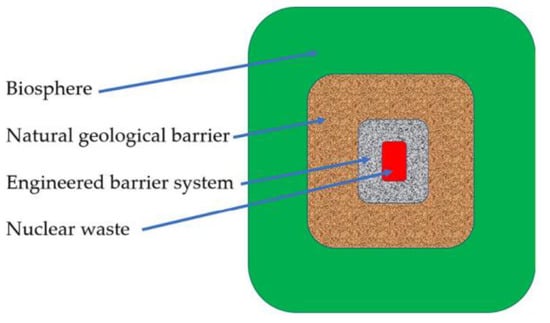
Figure 1.
Illustration of the multiple-barrier safety principle for GDF [1].
The worldwide practice of deep geological and near-surface RW deposition, as well as their designs, widely used cement and materials based on cement as engineered safety barriers (ESB) such as: matrices for immobilization of RW of low and intermediate levels of activity (LLW and ILW), concrete block or cement filling buffer, underground tunnel concrete plugs involving RW containers, as concrete lining of tunnels or boreholes in the host rock, and as a component of multi-purpose container (MPC) for the disposal of high-level waste (HLW) [5,6,7,8,9,10].
The use of cement in the disposal of RW and spent nuclear fuel (SNF) requires barriers based on cement to maintain isolation properties for several tens of thousands of years [6]. Therefore, to understand the possible mechanisms of adverse changes in cement-based materials under geological disposal facility conditions, there are a number of experiments carried out in situ at the GDF/DGR under construction (Grimsel test site, Switzerland; Äspö hard rock laboratory, Sweden; ONKALO underground research laboratory, Finland) and modelled under laboratory conditions [6,11,12,13,14,15]. Thus, the objective of this work is to analyze the international experience in the application of cement-based materials and their laboratory testing in projects and at existing (or closed) RW disposal facilities in deep geological formations. Consideration of this is relevant in connection with the development of the concept of a GDF on the territory of the Russian Federation in the Nizhne-Kansky Massif (Krasnoyarsky region).
2. International Cement-Based Materials Application in Design Concepts and Operating Facilities of RW Deposition
2.1. Cement as Matrix for LLW and ILW
Cement has a variety of physicomechanical and chemical properties, making it an appropriate barrier and matrix for immobilizing radioactive and toxic waste [16]. From the chemical perspective, hardened cement has a high pH (its pore solution) and forms hydration products with sorption and ion exchange properties. From a physical point of view, cement is a solid strong material with low hydraulic permeability in its hardened form, ensuring the safe transport and storage of radioactive waste. Cement is also an inexpensive and easily accessible material, durable in its cured form, liquid at the stage of its initial forming and resistant to various forms of radioactive waste, which can be incorporated into it in both its liquid and solid states [16]. Hydrated cement has also been found to be resistant to radiation and capable of acting as a radiation shield.
Three methods of cementing are used for different types of radioactive waste in international practices [16].
- Cementing directly in the barrel/container. During this process, the components, including radioactive waste, are mixed in a standard 200 L steel barrel using a single or interchangeable mixing element. After the cement is grasped and solidified, the barrel with the resultant compound is closed with a lid and sent to a near-surface disposal facility.
- Cementing by a mixing plant. In this method, cement and waste are mixed to a homogeneous state and poured into standard 200-L steel drums or containers. The barrel/container shall be locked and, once the strength has been established, disposed of in the near-surface facility.
- Cementing in situ. Radioactive waste cementing is often carried out on a large scale. For example, in India, 4 m3 tanks are used for radioactive waste conditioning, which are placed in a concrete ditch on a vermiculite layer. The air-conditioning tanks are interconnected at a certain level to avoid overflow. They are also equipped with one-time mixing mechanisms and a cement injection channel. All the tanks in the reinforced concrete trench are connected to an exhaust system equipped with a cyclone separator, filters and a blower. Since immobilization in cement is made inside the conditioning vats, this process is defined as «cementing in situ». This process is also used in the United States, where vats and bunkers of up to several million liters are filled with cemented radioactive waste.
Many countries have developed their approaches to the choice of curing materials, additives and process design. The experience is extensive [17,18]. Table 1 lists countries and enterprises where typical cementing processes and installations are used.

Table 1.
International experience in RW cementing [17,19].
Cement matrices serve to immobilize different kinds of waste: spent ion-exchange resins are typically immobilized using slag Portland cement mixtures; sludge and concentrates from LLW treatment are handled with ordinary Portland cement (OPC) with or without additives such as slag or fly ash; liquid ILW (LILW) are usually localized with slag Portland cement mixtures or OPC with vermiculite; mixture of sludge and ion exchange resins are isolated using OPC or slug Portland cement mixtures; secondary waste from the treatment of spent solvents at the processing plant, RW generated during processing SNF based on thorium and evaporator concentrate containing boric acid are immobilized using OPC [16].
For immobilization of high-level waste, the cementing method is not widely used due to the possibility of degradation of cement compounds under high radiation loads, causing radiolysis of water in cement pores to form free radicals with high reactivity [5]. However, in recent years, the Russian Federation’s work is underway to investigate the possibility of immobilizing high-level waste by cementing [20,21,22]. Along with HLW, in the planned variant of geological disposal on the territory of the Russian Federation, the isolation of cemented liquid ILW [23] is considered, which, despite the accumulated extensive experience in using this method in this particular country, requires consideration of international practices for cementing radioactive waste.
2.2. Cement as a Buffer Material for Radioactive Waste Disposal
2.2.1. Cement as a Backfill Material in the Deep Geological Repository Project for Long-Lived (LL) High-, Intermediate-, Low- and Short-Lived (SL) High-Level Waste (Belgium)
In the Belgian repository project [24], it is planned to dispose long-lived high-, intermediate- and low-level radioactive waste at a depth of 230–240 m in boom clays.
Radioactive waste containers will be located in 1 km of horizontal tunnels lined with concrete slabs in order to avoid swelling of the tunnel walls due to the plasticity of the clays. Waste packages will be arranged in relation to each other without gaps by pushing them along the tunnel. The tunnels will be covered with cement. The choice of cement as a backfilling and lining material is due to its ability to hold radionuclides properly for the required isolation time, display shielding properties in relation to ionizing radiation, its low cost and extensive application experience. The tunnels will be connected by a common gallery connected to the surface of the two shafts [25].
It is planned to dispose long-live low-level and intermediate level waste packages by placing them in a concrete reinforced container and then filling the voids between them with cement mortar to form monoliths, which, when placed in tunnels, are proposed to be backfilled with cement with a layer thickness of 10 cm (Figure 2c).

Figure 2.
Construction of «supercontainers» for high- (a,b) and long-lived low- and intermediate-level radioactive waste, and monolith (c) for long-lived low- and intermediate-level waste disposal [24].
The Geological Repository Project proposes the use of “supercontainers” for disposal of long-lived and short-lived high-level radioactive waste, which are canisters including RW placed in a carbon steel container filled with cement mortar. The high-level radioactive waste containers shall be filled with a 40–50 cm thick cement buffer [25] in the tunnel. Because the vitrified HLW and spent nuclear fuel assembly (SNFA) canisters emit different amounts of heat, the distance between the individual tunnels should be different: between vitrified HLW—50 m; with SNFA—120 m [25].
2.2.2. Cement Buffer NRVB (Nirex Reference Vault Backfill) in the Concept of Intermediate-Level Radioactive Waste Isolation in Geological Disposal Facility (United Kingdom)
A proposed radioactive waste geological disposal concept in the United Kingdom provided two separate isolation options at depths of more than 500 m below ground: cemented intermediate-level waste in horizontal tunnels, vitrified high-level waste and spent nuclear fuel in vertical boreholes. Cement and clay backfill, respectively, serve as buffers for these options [26].
The so-called high-alkaline cement buffer NRVB [27] was considered for the intermediate-level waste tunnel isolation option, which is a mechanical mixture of OPC with hydrated lime (calcium hydroxide, Ca(OH)2) and calcium carbonate (CaCO3) using the ratios presented in Table 2.

Table 2.
Composition of cement buffer mixture NRVB [26].
This buffer material based on Portland cement was developed in the 1990s to meet a number of requirements for geological disposal facilities in the UK [28], such as [28,29]:
- The high hydrogen index of the medium (pH) provided by the dissolution of the various mineral components of the cement buffer by underground water, which makes it possible to significantly reduce the mobility of many radionuclides;
- High porosity and, consequently, permeability to ensure homogeneous chemical conditions, allowing for the removal of gaseous products resulting from corrosion of metal components of radioactive waste (H2), activity of micro-organisms in aerobic and anaerobic conditions when they decompose organic radioactive waste (CH4, CO2), as well as a number of radioactive gases (containing isotopes 3H, 14CO2, 14CH4, 222Rn) [27,28] and the creation of a high specific surface area for the sorption of radionuclides;
- Low compressive strength of the material (4.9, 5.9 and 6.3 MPa on 7, 28 and 90 days of curing, unlike OPCs under almost identical conditions—31, 45 and 46 MPa on 7, 28 and 90 days, respectively [30,31]) to create a potential recovery of waste packages [28];
Although Nirex merged into Nuclear Decommission Authority and ceased to exist in 2007 [32], the NRVB cement buffer is being considered as an alternative option for geological disposal in the Nizhne-Kansky massif [33].
2.2.3. Cement Mortar as a Filler for Concrete Containers with Short-Lived Low- and Intermediate-Level Waste in Geological Repository in Bátaapáti (Hungary)
The nuclear power plant waste repository in Hungary is carried out in granite host rock at a depth of 250 m. Radioactive waste are converted to a solid state and then placed in steel barrels with a volume of 200 L. Further barrels, in turn, are placed in a concrete container, then filled with a mortar of cement compounds with liquid radioactive waste (Figure 3) [34].
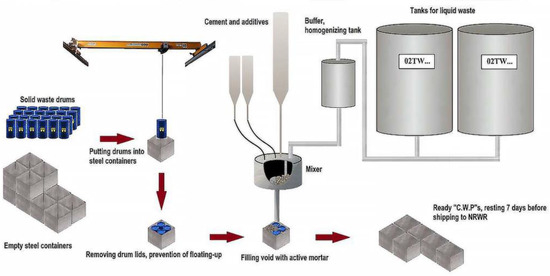
Figure 3.
Preparation of solid radioactive waste for disposal at the Hungarian nuclear power plant [35].
In this form, the obtained concrete containers with radioactive waste are transported to the geological repository in Bátaapáti, inside which they are placed in a chamber 90 m long [34].
2.2.4. Cement as a Component of the Backfilling Material in the Geological Repository of Low- and Intermediate-Level Waste at Morsleben (Germany)
The radioactive waste repository at Morsleben is located in salt rocks in unused mines. Due to the lack of up-to-date safety requirements for disposal facilities in Germany, the repository is currently being closed down until approximately 2028 [36]. This repository received solid and compacted waste in steel barrels of 200 L.
At the closing stage, mines with radioactive waste to reduce the flow of groundwater will be covered with a special composition: 16% cement, 39% halite, 16% lime, 14% water, 15% sand [25].
2.2.5. Cement Filling of Containers with Low-Level Waste of Geological Disposal Facility Cigéo (France)
According to the Cigéo [37] disposal facility concept, it is planned to be located at a depth of about 500 m in the Calloway–Oxford clay formations. The waste will be disposed of in solid form, arriving at the GDF already packed and further isolated on site in steel canisters, which will be placed in horizontal tunnels with metal lining. Long-lived intermediate- and high-level waste will be disposed in separate parts of the GDF and the size of the chambers for them will be: ILW—a few tens of meters in diameter and several hundred meters long; HLW—a few tens of meters in length and only 70 cm in diameter. When disposing of HLW, waste containers will alternate with buffer material to reduce the temperature in the cells shown in Figure 4.
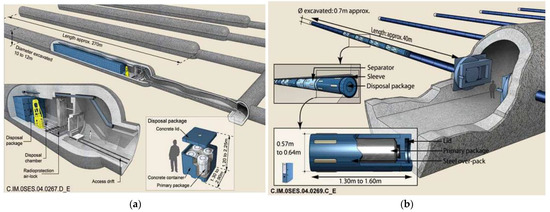
Figure 4.
Illustration of containers with intermediate- (a) and high-level waste (b) and the order of their placement in the tunnels of the geological disposal facility Cigéo [38].
Containers with intermediate-level waste canisters, after filling, shall be backfilled with cement mortar [38] to provide additional mechanical protection during transport and to create an additional engineered barrier, reducing the corrosion rate of a steel container when groundwater penetrates the disposal facility.
2.2.6. Special Cement Composition as Radioactive Waste Chamber filling Material for Low- and Intermediate-Level Waste in the Geological Disposal Facility Project (Switzerland)
Disposal of low- and intermediate-level waste in Switzerland will be carried out in geological formations of host rock formed from opalinus clay and/or clayey limestone. The intermediate- and low-level waste are isolated in solid form by means of cementing, bitumizing or alloying in a plasma furnace into a slag-like mass [25,39]. The waste is isolated in metal barrels, which are placed in a concrete container filled with cement mortar (Figure 5).
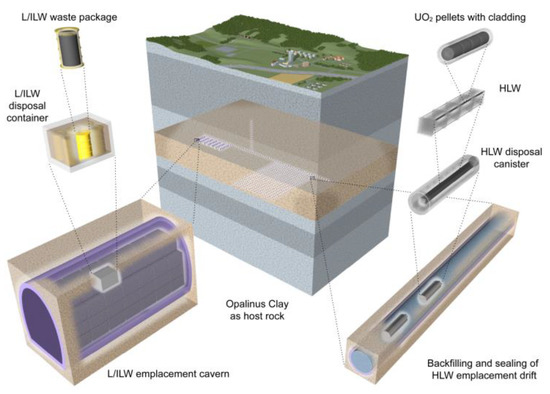
Figure 5.
Layout of ILW/LLW and HLW and organization of safety barriers around them in geological disposal facility project [40].
Radioactive waste containers will be located in several tiers in the tunnels of the disposal facility (Figure 5). At closing, the tunnel will be filled with cement mortar of increased viscosity, which will become an additional engineered barrier. The final safety barrier is clayey host rock [25].
2.2.7. Cement Backfilling as One of the Options to Fill the Gaps between Radioactive Waste Containers in the SFL Geological Repository Project for Long-Lived Low- and Intermediate-Level Waste (Sweden)
The SFL repository will be located in crystalline rocks at a depth of 300 m and is designed for long-lived low-level waste. The disposal facility will consist of two drifts: SFL-3 for legacy and operational waste; SFL-5 for decommissioning waste. There are four disposal options [25].
The first option involves filling radioactive waste with gravel, the second —placing the waste inside the concrete structure and filling the free space with cement mortar, the third—placing the waste inside the concrete structure and filling the free space with bentonite briquettes. The fourth version of the concept involves the disposal of waste in a bunker with double concrete walls. The bunker will be installed on a gravel base, the space between the outer wall of the bunker and the surrounding rocks will be filled with gravel. The space between the inner and outer walls will be filled with bentonite (top and sides) and a mixture of bentonite and sand (bottom). After filling, the bunker will be covered with gravel up to the ceiling of the tunnel. The bunker will be 40 m deep and 35 m in diameter [25].
2.3. Concrete as a Material for Lining and Isolation of Tunnels for Radioactive Waste in Geological Repository/Disposal Facility
The use of concrete as a material for lining and isolating repository tunnels is explained by its low cost, extensive experience in construction, the ability to firmly retain radionuclides during the period of radioactive waste isolation, shield ionizing radiation, provide acceptable hydraulic permeability of tunnels from the penetration of groundwater of repository/disposal facility and reduce corrosion rates on surfaces of steel containers [25].
2.3.1. Concrete as Material for Tunnel Lining in the Host Rock of Bátaapáti National Radioactive Waste Repository (Hungary)
As a result of the change of the concrete container for repository of low- and intermediate-level waste in the National Geological Repository in Bátaapáti (Hungary), the construction of the chambers with radioactive waste was changed: tunnels in the host rock began to reinforce concrete facing. The chambers shall be divided into blocks for additional reinforcement of the structure and the addition of a step-by-step backfilling of the chambers [41].
2.3.2. Concrete as a Drift Lining Material in High-Level Waste and Spent Nuclear Fuel Deep Geological Repository Project (Spain)
At present, Spain is continuing to develop the concept of high-level waste and spent nuclear fuel repository, which is based on the most widely used in the world: HLW and SNF containers will be placed in drifts in granite or clay rock, surrounded by blocks of compacted bentonite as buffer [42].
It is also planned to ensure lining and plugging of geological repository drifts using concrete [6,13] as an additional engineered safety barrier.
2.3.3. Concrete as a Material of Tunnel Plugging, Isolation of Waste Chambers in the Low- and Intermediate-Level Waste Repository Project in the Municipality of Kincardine (Canada)
The placement of radioactive waste in the geological isolation facility project is planned at a depth of 680 m in clayey limestone under Bruce site, not far from the municipality of Kincardine, Ontario [43]. The proposed repository concept is depicted in Figure 6 and consists of parallel rows of waste cells located on either side of the central access tunnel: on one side there will be cells for LLW and on the other there will be cells for ILW [43].

Figure 6.
Proposed concept of placing LLW and ILW in the Bruce site repository and illustration of disposal cells with (1) low-, (2) intermediate-level waste and (3) operations to place radioactive waste in SFR repository (Sweden), much like those in the planned Canadian one [43,44].
It is planned to strengthen the floor of the radioactive waste cells with concrete, and after filling it with concrete wall without backfilling and sealing [43]. Access shafts to the cells will be isolated with concrete caps and low-permeable materials, in particular a mixture of bentonite and sand [43].
2.3.4. Concrete as a Lining and Plugging of Tunnels Material with Intermediate- and High-Level Waste in the Project of Geological Disposal Facility Cigéo (France)
Tunnels for intermediate- and high-level waste placement in the Cigéo geological disposal facility [38] are planned to be supported from the inside by the application of shotcrete on the walls with additional strengthening in the form of various reinforcements, after which the tunnel is cladded with non-reinforced concrete (Figure 7).
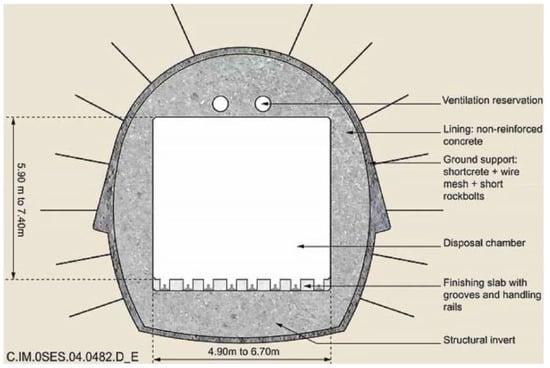
Figure 7.
Concrete reinforcement and lining on the example of the cross-section view of tunnel for isolation of the intermediate-level waste in the tunnel of the geological disposal facility Cigéo [38].
After the end of the operation of the disposal site, the waste tunnels will be sealed with bentonite and concrete blocks (Figure 8) [25].
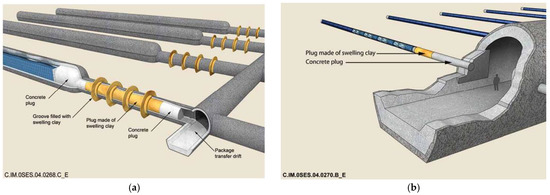
Figure 8.
Layout of intermediate- (a) and high-level waste (b) in the tunnels of the Cigéo geological disposal facility and their isolation with concrete plugs [38].
2.3.5. Concrete as Bunker Lining Material of the Short-Lived Low- and Intermediate-Level Waste Geological Repository SFR (Sweden)
The SFR repository for the low- and intermediate-level waste (Sweden) is located at the Forsmark Nuclear Power Plant under the Baltic Sea at a depth of 60 m in crystalline host rock [45].
The most active low-level waste is disposed in a cylindrical bunker SILO (Figure 9), located in a shaft with a diameter of 30 and a depth of 60 m, lined with 0.8 m thick concrete, based on sand and bentonite [25]. The low-level waste is emplaced in the bunker in containers made of steel or concrete, the voids between which are filled with cement mortar [45].
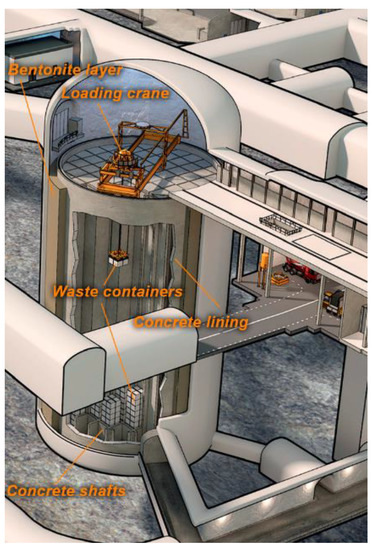
Figure 9.
SFR repository SILO bunker cross-sectional view [45].
2.3.6. Low-pH Concrete as Tunnel Plug Material in Design Concepts for High-Level Waste and Spent Nuclear Fuel Deep Geological Repository KBS-3 (Sweden, Finland)
The KBS-3 concept provides for isolation of high-level waste [46] and spent nuclear fuel [47] in crystalline host rock [48]—granite [49]. Two variants of radioactive waste containers emplacement are considered, the schematic of which is shown in Figure 10—vertical in boreholes (KBS-3V) and horizontal in tunnels (KBS-3H) [33,49,50].
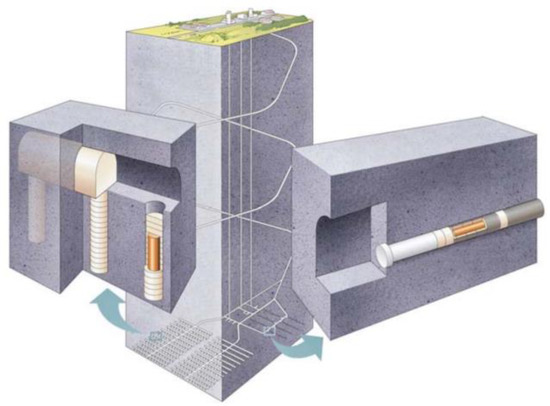
Figure 10.
Cross-sectional view of vertical (KBS-3V, left) and horizontal (KBS-3H, right) method of radioactive waste container placement in KBS-3 concept [49].
In either variant, the installation of radioactive waste containers inside the buffer made of compacted bentonite is considered and should be plugged after the final filling (for KBS-3H, additional plugs are also provided inside the tunnel to isolate individual compartments with radioactive waste) [49,50]. In the case of KBS-3V, low-pH concrete, the composition of which is indicated in Table 3 (kg component per m3 concrete) [49,51], while for KBS-3H decided to abandon concrete, since the Äspö hard rock laboratory experiments revealed the following conditions that the reinforced concrete plug could not withstand: hydrostatic pressure (5 MPa) and swelling pressure of the compacted bentonite (<10 MPa) [50].

Table 3.
Composition of low-pH concrete B200 for plug construction in KBS-3 repositories [51].
The report [52] analyzed the effect of adding superplasticizers on the mobility of radionuclides of the lanthanide and actinide groups under conditions of high pH values typical for cement materials and under conditions of model groundwater solutions. The results of the work in the report showed that under strongly alkaline conditions, there was no significant effect on the sorption of radionuclides Eu, Th and Ni on cement materials. However, in model solutions of groundwater, additions of superplasticizers containing carbohydrates/carboxylates led to effective complexation of trivalent lanthanides and actinides, and at lower pH, to binding of tetravalent actinides. This phenomenon should be taken into account when designing a geological facility for the isolation of radioactive waste, because under these conditions, the mobility of radionuclides increases. The effect of radiolysis products of various types of superplasticizers on the mobility of Eu, Ni and U was analyzed in [53]. Under alkaline conditions, at a concentration of radiolysis products of the order of 10−2 mol/L, they do not have a significant effect on the mobility of the studied radionuclides. However, in a weakly alkaline medium (pH = 8–10), such radiolysis products as phthalic and acetic acids (at concentrations of about 10−2 mol/L) increase the mobility of Eu and Ni, while none of the studied radiolysis products had no effect.
As of 2008, two design options for concrete plugs have been proposed: long conical (Figure 11) and short reinforced (Figure 12). Each of the proposed options provided both with and without bentonite intermediate layer [49].
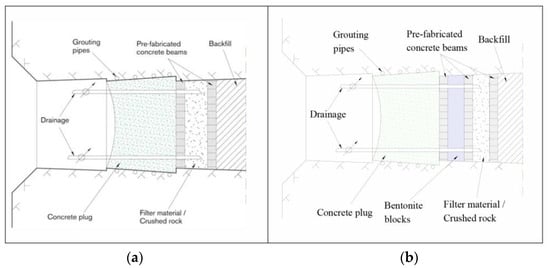
Figure 11.
Design of conical concrete plug without (a) and with an intermediate bentonite layer (b) between the filling of the tunnel and the plug itself [49].
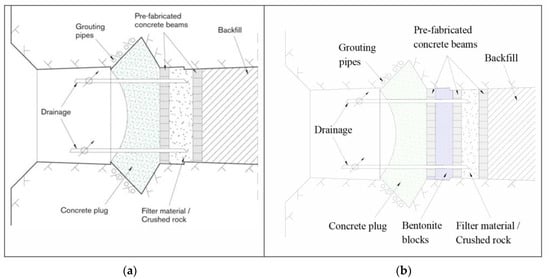
Figure 12.
Design of short reinforced concrete plug without (a) and with an intermediate bentonite layer (b) between the filling of the tunnel and the plug itself [49].
Based on the experimental reports of the Äspö [54,55,56] hard rock laboratory, SKB has opted for a short reinforced plug with an intermediate layer of bentonite. The use of low-alkaline concrete is explained by the need to preserve the bentonite buffer’s previous swelling ability, which is severely degraded in the strong alkaline solutions formed by filtering underground water through concrete structures [49].
2.3.7. Concrete as Lining and Plugging Material in the Geological Disposal Facility Design Concept of Disposal High-Level Waste and Transuranic Spent Nuclear Fuel (Japan)
The Japanese geological disposal facility design concept plans to place transuranic radioactive waste packages in horizontal tunnels (Figure 13) at a depth of ~500 m [57].
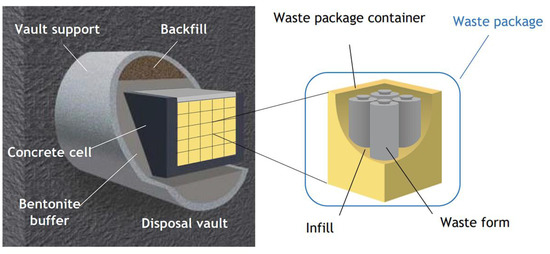
Figure 13.
Illustration of transuranic radioactive waste emplacement in Japanese project of geological disposal facility [58].
It is planned to place transuranic radioactive waste canisters inside the container, after which the cement mortar is poured. The containers will be placed in a concrete lined tunnel filled with a bentonite buffer [57,58] and mechanically isolated by a concrete plug (Figure 14) [57,58].
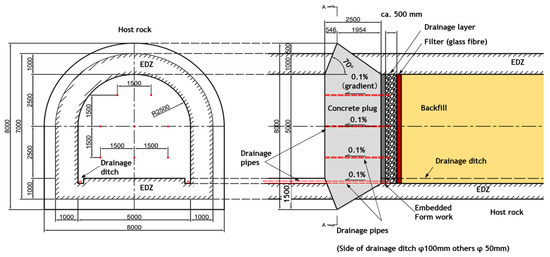
Figure 14.
Concrete plug for horizontal tunnel isolation in Japanese geological disposal facility project [58].
In vertical placement, radioactive waste is considered as an option, lining the borehole with shotcrete (Figure 15) to ensure mechanical stability until it is filled with buffer material [58].
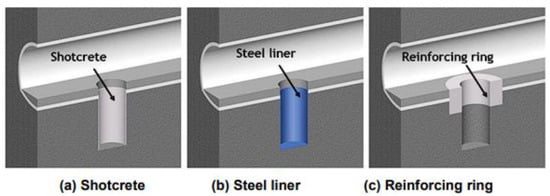
Figure 15.
Borehole reinforcing options in Japanese disposal facility development reports [58].
2.4. Conclusions
Table 4 below provides basic information on foreign practices of radioactive waste disposal using cement-based materials, including concrete.

Table 4.
Overview of the use of cement-based barriers.
Analyzing the above information, it can be said that in almost all concepts of radioactive waste deposition in deep geologic formations, concrete (cement) is used as an engineered barrier material. The use of cement by its type of application can be classified as follows:
- Radioactive waste contained in cement matrices inside steel drums;
- The material of radioactive waste conditioned container and/or its buffer;
- Buffer material between radioactive waste container and storage walls;
- The material of the lining of the walls of the storage;
- Material isolating tunnels with placed radioactive waste packaging structures (tunnel plugs, walls and seals).
According to the radioactive waste-type arrangement, cement-based geological reservoirs can be classified as tunnels (horizontal) and boreholes (vertical).
In the Russian Federation, a number of radioactive waste GDF concepts in both horizontal and vertical landfills are being considered, each of which assumes the use of cement materials in accordance with the waste composition under consideration. At this disposal facility, the final isolation of RW of classes 1 and 2 is planned [33]. RW class 1 is formed as a result of the processing of SNF containing a number of radionuclides [59] (Table 5), including radioactive isotopes of iodine (for example, 129I), which are especially dangerous for the biosphere. For reliable isolation of radioactive waste containing radioactive iodine, a number of effective sorbents containing silver compounds based on materials with a developed surface such as, for example, bentonite and silica gel [60] are currently being developed. The inclusion of a certain amount of modified bentonite capable of sorbing iodine into the composition of the compacted buffer will preserve the performance properties of bentonites and ensure environmental protection from radioiodine.

Table 5.
Specific activity of significant radionuclides from VVER-440 and BN-600 nuclear reactors SNF [59].
Options for creating a buffer zone include pouring cement mortar between the vertical boreholes with the RW class 1 supercontainers (high-level waste with high heat generation) (Figure 16) [61].
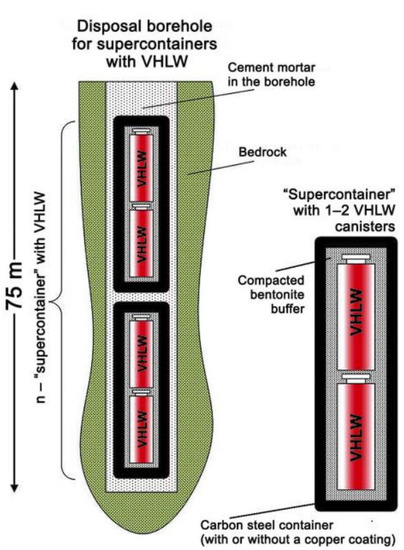
Figure 16.
RW class 1 isolation option in cement mortar boreholes [61].
As the advantages of using cement backfilling, the authors of the work [61] indicate a decrease in the corrosion rate of the supercontainer in an alkaline medium caused by the dissolution of the cement buffer components by groundwater, as well as the possibility of sealing cracks in boreholes, while the probable scenario of erosion of the bentonite buffer by its «washing up».
Currently, the entire level of uncertainty is being assessed for the final decision on the choice of the concept of the organization of deep deposition of radioactive waste in the Russian Federation. In addition to the analysis of the existing concepts of GDF, it is necessary to analyze and change the key properties of EBS elements, their mutual influence and other related processes in disposal facility, which will be discussed in the next section of this article.
3. Changes in Concrete Engineered Barrier by Means of External Factors of Geological Disposal Facility
Since radioactive waste deposition in deep geological formation should be designed to isolate the waste over a long period of time, it is necessary to predict possible changes in the main properties of concrete engineered safety barriers based on the analysis of the influence of many factors, such as: the effect of high temperatures and radiation doses, typical for high heat generating high-level radioactive waste; infiltration of groundwater characteristic of the containment environment; exposure of microbial communities and others.
3.1. Concrete Changes Due to Elevated Temperatures (above 100 °C) Typical for RW Class 1 Packages
Cement is being actively investigated as a backfilling material for low- and intermediate-level waste repositories and is also being considered for use in the radioactive waste large heat release geological disposal concept, for example in the Belgian supercontainer concept for high-level waste and spent nuclear fuel. The use of cement as a backfill in geological disposal facilities is conditioned by its ability to provide structural support, its ability to be used as a backfill directly inside the geological disposal facility, its ability to provide alkaline conditions, which reduce the corrosion of steel and the solubility of some important radionuclides and increase their sorption [62].
The effect of continuous exposure to elevated temperatures has been found to cause the following changes in the properties of the concrete [62]:
- Compressive strength decreases by about 25% at the specified maximum temperature of the operating geological disposal facility of 300 °C and continues to decrease with greater force when this limit is exceeded. Strength degradation tends to increase when cement dries.
- Modulus of elasticity decreases in volume than strength and is a more sensitive parameter to external influences. The relative modulus tends to decrease linearly from 100 °C to almost zero at 800 °C but fluctuates strongly at 300 °C—the relative value is in the range of 40 to 90%. However, this significant reduction of the elastic module does not endanger the integrity of the geological disposal facility barriers. Maintaining a high modulus of elasticity is critical if the strain under the load is limited. In the geological disposal facility, the primary load at elevated temperatures will be the result of limiting temperature and shrinkage strains. Under these conditions, achieving a low elastic modulus value is useful because it reduces the stresses caused by limiting deformation and therefore reduces the risk of cracking.
- Temperature expansion coefficient of concrete is approximately constant at the maximum operating temperature of 300 °C, with a value of 10 ± 2·10−6 mm/(mm·°C). For cement mortar, deformation at elevated temperatures can be reinforced by shrinkage during drying, so the final deformation is caused by shrinkage.
- Thermal conductivity of concrete decreases approximately linearly over the entire range of 20 to 300 °C, with a relative coefficient of thermal conductivity around 0.4.
- Hydraulic permeability of concrete increases with temperature. This conclusion is based on a limited amount of data on the change of porosity of concrete at elevated temperatures and using information on the permeability to porosity ratio, its estimated value, assumed for the maximum operating temperature of 300 °C may be 10 times higher than for the standard temperature. This could result in a high flow rate of groundwater through the geological disposal facility barriers, even though the effect of changes in cement materials would be relatively small and comparable to cracking.
The work [63,64] describes the study of the mechanical and thermal properties of concrete, which were grouped into a visual diagram (Figure 17) that describes the physical and chemical processes that occur in concrete when the temperature increases.
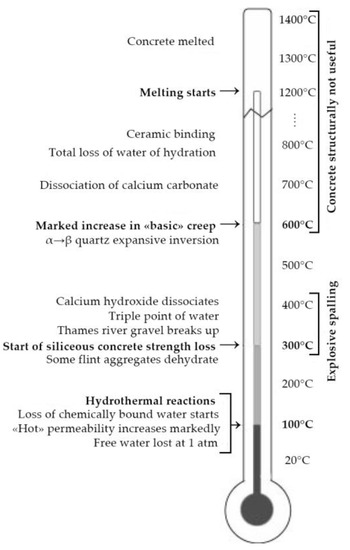
Figure 17.
Physicochemical changes in concrete from ordinary Portland cement in heating process [63].
3.2. Changes in Concrete Due to Groundwater in Geological Disposal Facilities
When groundwater enters the geological disposal facility, its active components, such as calcium hydroxide and amorphous cement CSH-gel formed by means of hydration of the ordinary Portland cement, dissolve with cement insertion. Assessments based on accelerated leaching of NRVB cement material (considered to be an analogue of the cement barrier for RW class 2 in geological disposal facility at Nizhne-Kansky massif) showed that it contains a sufficient amount of Ca(OH)2 to maintain pH > 12 in the volume of underground water passing through it, more than 200 times the volume of cement backfill. Once Ca(OH)2 is dissolved, high pH will be achieved by dissolving the CSH-gel. The volume of water with pH > 10 is about 800 times higher than the volume of the gel. Consequently, the required volume of groundwater to maintain a high pH is about 1000 times that of NRVB [61]. The dissolution of Ca(OH)2 groundwater and CSH-gel from the concrete structure should lead to an increase in porosity and, consequently, a decrease in strength.
The evaluation determines that the volume of cement around containers with a diameter of 0.7 and a height of 3.5 m in the geological disposal facility, where the average hydraulic permeability (filtration coefficient) (0.04 m/year) and the hydraulic pressure gradient (0.05) determines the average flow of groundwater at the vertical location of the wells to be approximately 19 m3, which corresponds to a borehole diameter of just over 2.5 m, the flow of which is not subject to technological difficulties [61].
In the absence of changes to the cement geological disposal facility in evolution, except for interaction with groundwater, groundwater conditioning for very high level waste (VHLW) at Nizhne-Kansky massif will be possible for a million years after closure [61]. This conclusion made by the authors in [61] is based, as mentioned earlier, on the approximation that the mineral composition of the cement buffer does not change as a result of groundwater filtration and their following interaction. To obtain more complete data of the duration of chemical containment, it is necessary to take into account the passivation of the mineral surfaces of the cement buffer, which occurs as a result of the interaction of carbonate- and sulfate-anions contained in the underground water of the Yeniseisky site with Ca(OH)2, followed by gypsum and calcite precipitation.
In the experiment [65] tests were carried out to determine the hydraulic permeability of concrete (filtration coefficients) on a specially prepared setup (Figure 18). For this experiment, cylindrical concrete samples were prepared with the addition of a silica fume in the ratio of 60% of the ordinary Portland cement, 40% of the silica fume and the amount of water relative to the binder is 0.5 (i.e., water-cement ratio, W/C), measuring 5 cm in diameter and height, and also cores from the plug of the test site Äspö (Sweden) of the same size, made of shotcrete. Samples of concrete with the addition of silica were hardened for 2 years. Through these samples, the granite underground water of the Äspö site was passed under pressure of 0.5 bar to simulate the actual conditions of the further repository [65].
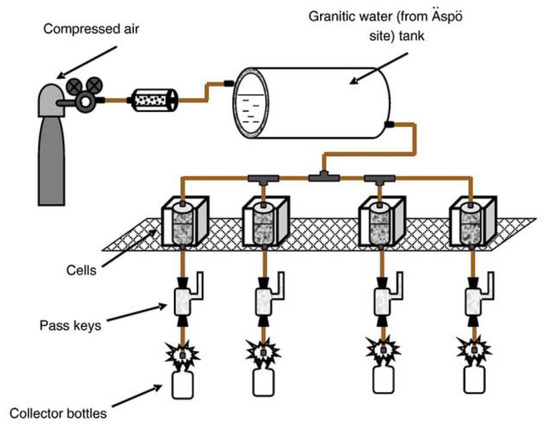
Figure 18.
Experimental setup [65].
Cylindrical samples of concrete were placed between two cylinders made of methacrylate with holes for inlet and outlet of incoming water. To pass the water in the right direction, the samples were hydroisolated with epoxy resin shell. For collecting the water passed through the samples, reservoirs are provided (Figure 19). To determine the hydraulic permeability of the concrete, the flow from the granite water concrete cells was measured. These tests were carried out over a period of 14 months for silica-fume concrete and 2 years for shotcrete [65].
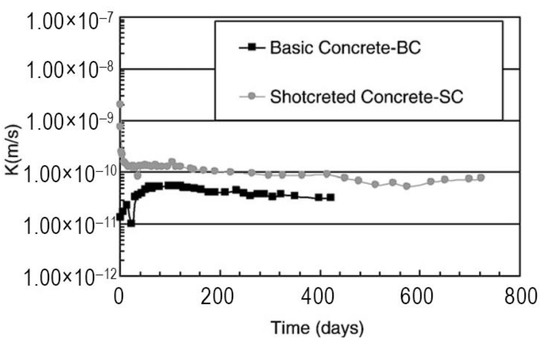
Figure 19.
Variation of hydraulic permeability of concrete over time of the experiment [65].
The hydraulic permeability of the concrete must be of rock-like order (which is 10−10 m/s) for the granite high-level waste disposal facility. This parameter satisfies this requirement and is stable throughout the test period (Figure 19), indicating a high stability of the material [65].
It should be noted that the hydraulic permeability of the shotcrete is slightly higher than that of the basic concrete due to the increase in porosity caused in the material by the process of shotcreting [65].
In the paper [66], the experiment on interaction of samples (cylinders 12 mm in diameter and 10 mm in height) of concretes on the basis of cement grade CEM III A/S 42.5 N (W/C = 0.6), with model solution of underground water of the Yeniseysky site potential site for the deep geological isolation of radioactive waste in crystalline rock (i.e., Yeniseysky site at Nizhne-Kansky massif). The composition of the model solution was selected on the basis of information in [67,68] by dissolving in distilled water the following mineral salts: CaCl2·2H2O, NaHCO3, MgSO4·7H2O, KCl. pH of the medium was corrected to 7 by adding small amounts of caustic soda solution. The composition of the model solution produced is shown in Table 6.

Table 6.
Composition of the model solution of the underground water of the «Yeniseysky» site before and after the experiment (10−4, mol/L) [66].
The concrete and groundwater interaction experiment was conducted in polytetrafluoroethylene (PTFE) cups with a lid in the dryer at a temperature of 90 °C for 40 days at a ratio of solid to water of 1:6 [66]. The composition of the modified water phase as a result of the experiment is also given in Table 6.
The study found that the interaction of concrete with the model solution led to the slight dissolution of Al, Si, the transition of a significant amount of Na and K to the aqueous phase, while in the solid phase Cl−, SO42−, HCO3− and, to a large extent, Mg and Ca. pH increased almost twofold, from 6.1 to 12.1 [66], which, according to Table 6 and a series of studies [69,70,71], is due to leaching of Na+ and K+, resulting in increased hydroxyl anion concentrations displacing the equilibrium of the dissolution reaction of Portlandite (Ca(OH)2) in the opposite direction. The increase in Mg content in concrete at sufficient concentrations in the aqueous phase may be due to a substitution reaction of Ca, or in silicate minerals or the formation of magnesium sulfate, as described in [72].
Phase change of the concrete was studied using the X-Ray Diffraction method (XRD). After the interaction of groundwater and concrete, there was a decrease in the content of the main phases, namely water, portlandite and gypsum, while the amount of α-C2SH, alite and belite increased. It was also noted that the mineral phases awfilite and nordstandite [66] were not previously presented in the original samples.
Porosity change has been studied by several methods—scanning electron microscopy (SEM), polymolecular nitrogen adsorption, computer microtomography (µ-CT). The results of µ-CT showed an increase in the relative volume of the macropore from 29.23% to 43.80% (Figure 20c—pores are shown yellow on the concrete model) [66]. The increase in the pores on the exterior surfaces of the specimen is due to the fact that they were phase boundaries when the concrete came into contact with the model solution, which naturally led to an increase in the number of macropores in that region.

Figure 20.
Illustration of the change in porosity of concrete sample as a result of interaction with the model solution. (a)—photo of samples before and after the experiment; (b)—3D model of samples, obtained with the help of µ-CT; (c)—relative porosity, detected using µ-CT (% of volume) [66].
The porosity analysis by SEM and the use of the STIMAN software found that the pore shape on the outer surfaces is more spherical than inside the specimen based on the dependence of the obtained probability density values (Ni/(N*1)) from the coefficient of pore distribution (Kf) (for spherical pores Kf = 1). The exposure to groundwater caused a change in the pore morphology outside the specimen to an even more spherical. It was also found that the maximum equivalent pore diameter on the outer sides increased from 162 μm to 259 μm during the experiment. However, the change in porosity is more complex: there was an increase in the contribution of pores >10 μm when the contribution of diameters of 1–10 μm to the total porosity decreased [66].
Thus, the main changes in the porosity of the samples are due to the dissolution of a part of the constituents of the initial samples of concrete phases during the experiment [66].
3.3. Effects of HLW Irradiation on Concrete Properties
In the work [20,21,22,73], concrete samples were tested at absorbed doses of γ-radiation from 106 Gy, used in various sources to determine changes in individual properties of cement compounds under the action of radiation loads, up to the value of 108 Gy, regulated by GOST R 50926-96 [74] for cured high-level waste. The results showed that the cement compounds at the dose range had no visual marks of mechanical damage in the form of chipping and cracking, maintained a high compressive strength, which was 4–8 times higher than the regulated value for solidified high-level waste (5 MPa). When comparing the phase composition of samples before and after irradiation in the studied ranges of the values of absorbed doses by the method of XRD, TEM and SEM, it was established that the change does not occur the formation of defects in the structure and changes in the phase composition. Furthermore, by measuring the plasma spectrum of gases emitted by irradiation of concrete samples in a gamma chamber, radiolytic gas formation under high dose loads was estimated. The spectrum was formed as a result of optical breakdown when focusing laser radiation in the volume of the sealed vial. Experimental data show that the maximum hydrogen release does not exceed 10−3 mol/(g of the sample) at 108 Gy. Thus, it is shown that engineered barriers based on ordinary Portland cement are able to maintain their physical-mechanical properties, phase composition and structure under the exposure of radiation loads equivalent in magnitude to radiation from high-level waste during disposal.
3.4. Influence of Biogenic Processes on Cement Material Properties
According to the research conducted on the territory of the Russian Federation in near-surface repository of FSUE «Radon» on biodegradation of cemented nitrate-containing radioactive waste, bacteria have been identified from the genus Pseudomas, resulting in the formation of carbon dioxide, acetate, propionate- and butyrate-ions, which led to carbonization and transfer of hydrate minerals of the matrix into soluble forms, which entails degradation of physical-mechanical properties of the compound by leaching [75,76,77,78]. These phenomena caused microfractures and pores in cemented radioactive waste. In [79], the structure of cement compounds made with and without biocide additives was analyzed and compared after 8.5 years of storage.
Cement matrices without the use of biocidal additives are distinguished by the presence of isolated phases of crystalline nitrate and calcium hydrocarbonate having a high solubility in water. This leads to reduced reliability of immobilization of radionuclides and mechanical strength of cement matrix. This cement compound largely contains biogenic acid breakdown products of calcium hydrosilicates (<10–12%), which causes microstructure breakdown. At the same time, cement matrices with biocidal additives have a monolithic and denser structure [79,80].
The intended materials for use as engineered barrier in the at Yeniseysky site will be in contact with the host rock in the presence of an indigenous and externally impacted microbial communities. There is also a high probability of intensification of microbiological processes due to heat dissipation from packages with radioactive waste and the release of gases that are products of radiolysis and involved in microbial respiration processes (H2, CH4, CO, etc.), the output of biogenic elements from matrices: phosphate from glass matrices, iron from steel containers, potassium, sodium, calcium, as well as organic matter from clay materials containing waste [75].
Thus, when designing a geological disposal of radioactive waste, it is necessary to take into account the impact on the concrete elements of engineered barrier systems of a number of factors listed in Table 7.

Table 7.
Transformation of barriers based on cement materials under external factors of geological disposal facility.
4. Influence of Concrete on Individual Component of Engineered Barrier System under Exposure of Conditions of Geological Disposal Facility
During the operation of the geological disposal facility, concrete (due to the creation of a highly alkaline environment) can have a negative effect on other engineered barriers: bentonite, steel containers, glass matrices of class 1 radioactive waste. Therefore, it considers necessary to this impact in order to predict their behavior in the long term in order to possibly prevent a negative scenario.
4.1. Changes of Bentonite Clay Buffer Properties under the Exposure of Model High-Alkali Conditions of Cement/Concrete
Many concepts of deep repositories of radioactive waste in suggest the use of a buffer based on compact bentonite clays [81,82,83,84,85,86,87] due to its unique characteristics such as: temperature resistance, essential physico-mechanical and preferred physico-chemical properties [88,89,90,91,92,93,94,95,96], exceptional swelling ability [97,98,99], resistance to aggressive media, (simulating bentonite structure destruction) [100,101], high specific surface area, cation exchange properties, their sorption characteristics in relation to radionuclides [81,102,103,104,105,106].
Since the many concepts described in Section 2 intend to place bentonite in the DGR/GDF in contact with concrete structures, it will be mainly influenced by the transfer of dissolved phases of concrete by groundwater to the compacted clayey buffer material [6,13].
Short-term interaction (90 days) of concrete leaching products with model solution of groundwater of granite massif (Table 6) and bentonite of 10th Khutor deposit (Republic of Khakassia, Russian Federation) are in operation [66]. At 90 °C, specific surface area increased by a factor of 1.5, which should have a positive impact on its sorption properties and reduce the number of macropores. In a strong alkaline medium, the dissolution of quartz and feldspars occurred, which influenced the change of phase composition towards an increase in the content of montmorillonite—the main component of bentonite clays [66]. The X-ray fluorescent analysis (XRF) showed an increase in calcium, sodium and potassium content, which may be due to substitution of divalent magnesium with sodium and potassium in the interlayer space [66] that at low compaction densities may lead to a slight improvement in bentonite swelling capacity [81,87,105]. Geochemical modelling in a 450-day period of [66] based on the experimental data obtained showed high bentonite stability: solubility constants in the kinetic equation were significantly lower than those described in the literature [106] including work on mathematical models of bentonite dissolution [107,108].
In [109,110,111] the influence of alkaline activation (short-term effect of alkali at a temperature of order 100 °C) of bentonite clays has been studied and no negative changes in properties such as cation exchange capacity (CEC), specific surface area (SSA). The results in [109,110,111] illustrate the increase in the specific surface area, in [111] cation exchange capacity there was a slight change, and in [109,110] there was an increase in the interphase distribution coefficient relative to the radionuclide of 137Cs and the same values for 90Sr.
In [112,113,114,115] the influence of strong alkaline solutions on swelling pressure, hydraulic permeability (filtration coefficient) and cation exchange capacity of bentonite clays was investigated. As a result of exposure to bentonite of MX-80 of NaOH solutions with concentrations of 0.1, 0.3 and 1.0 mol/L within 45 days [112] significant reduction of swelling pressure at the concentration of alkali > 0.3 M, corresponding to pH 13,3, which is typical for fresh cement mortar [112]. At a pH close to that of Ca(OH)2 (12.4, when 0.1M NaOH had a pH of 12.9), characteristic of the hardened concrete, no significant change in swelling pressure was found [112]. In [113,114,115], the effect of strong alkaline solutions on Chinese bentonite Gaomiaozi (GMZ) has resulted in a significant reduction of cation exchange capacity, swelling pressure and increased filtration coefficients, which are exacerbated by higher temperatures.
4.2. Interaction of Engineered Barrier Materials in the System «Concrete-Steel» under the Exposure of Groundwater
4.2.1. Influence of Low Oxygen Content and High Pore Cement Solution pH on the Integrity of Steel Packages after Closure of Geological Disposal Facility
One of the corrosion effects of steel containers for radioactive waste on the chemical composition of underground water is the absorption of free oxygen. Oxygen absorption will lead to a reduction medium with low oxidative potential. Corrosion products shall henceforth maintain reducing conditions [116]. An assessment of the oxidation-reduction potential of the Nirex-type disposal facility calculated that the oxidative potential would be held in the range of −400 to −600 mV at pH 12.5 and 25 °C. It was found that the oxidizing-reducing potential is maintained by the oxidizing-reducing chemistry of iron and uranium. The study also provided a simple estimate of the duration of the recovery. Based on the quantities of iron and uranium expected in the Nirex disposal facility and typical groundwater flow, the work suggested that the remediation conditions could be maintained in the storage environment for at least a million years [116].
In the long term, according to the study [116], the corrosion rate of a steel container in the Belgian deep geological repository high-level waste and spent-nuclear fuel in an alkaline environment provided by a cement buffer (pH~13.6) should be <0.1 μm/year with subsequent decrease. When using pressure sensors, the corrosion rate under anaerobic conditions was measured at 0.03 μm/year, which should mean the loss of 3 mm layer of container material over 100,000 years, confirming the high corrosion resistance of steel in a high alkaline environment under anaerobic conditions [116].
4.2.2. Pitting Corrosion and Stress Corrosion of Steel Super Container Material under the Action of Cement Pore Solution with pH~13.6
In [117], it was found that at room temperature (and low concentrations of chloride-anion), the critical potential of pitting corrosion lies in the O2 release area, but is rapidly shifted to negative values when temperature increases. The presence of sulfide anions (up to 500 mg/L) does not appear to increase the risk of stress steel cracking in a solution simulating the composition of pore concrete solution under oxygen-free conditions.
4.2.3. Formation of Iron Sulphides on the Surface of a Steel Container in Contact with Groundwater with Low-Alkali Cement and Related Corrosion Mechanisms
In work [118], steel samples were immersed in a special cement mortar with low pH, the composition of which was developed for geological disposal facility Cigéo (France), and left for 6 months in oxygen-free conditions at 80 °C. The layers of corrosion products were analyzed using µ-combination spectroscopy as well as XRD and SEM. It turned out that they were mostly composed of iron sulfides, with the addition of magnetite as a secondary phase mixed with cement mortar components. The average corrosion rate was estimated by mass loss measurement and ranged from 3 to 6 µm/year. Corrosion profiles showed local fractures up to 10 µm deep. The heterogeneity of the corrosion layer consisting mainly of conductive compounds (FeS, Fe3S4 and Fe3O4) is assumed to contribute to the retention of corrosion cells, which may lead to locally aggravated degradation of the metal.
4.3. Influence of Cement Materials on the Solubility Rate of Vitrified RW Class 1
The impact of cement materials on the dissolution rate of the glass matrix for radioactive waste is the least studied, and the available data mainly refer to borosilicate glass, significantly different from sodium-aluminophosphate glass, planned for in first order for disposal in Russia. Laboratory experiments with model vitrifying and solutions show a high dissolution rate, but taking into account the real composition of GW (groundwater) and contacting engineered barriers can reduce conservatism of preliminary estimates. In conditions close to neutral (pH 7), the initial stage of glass-water contact dissolution is characterized by diffusion of water molecules into the glass structure and ion exchange (stage I), and then by hydrolysis of the glass structure, leading to an output into the element solution glass-formers (stage II, «mode of initial dissolution»). These processes lead to the formation of a structure on the surface of glass (gel) depleted with soluble components. With further dissolution, there is a significant decrease in the speed of the output of glass components into the solution (stage III, «dilution mode»), after which the rate of dissolution becomes relatively constant, by 3–4 orders of magnitude below the characteristic value for stage II. This phase is called stage IV or «residual dissolution mode». In some cases, after stage IV, the dissolution rate again increases (stage V). These mechanisms are well known, but in some cases, they emit less «stages» of dissolution. The dissolution rate of glass in phase II depends on the pH of the solution: it increases significantly in both acidic and alkaline environments [61].
4.3.1. Dissolution of Borosilicate Glass, a Material of Vitrified HLW in Air Conditioning Practice, under the Action of Groundwater Contacting Cement, as a Material of Engineered Safety Barrier
The dissolution rate of glass in phase II depends on the pH of the solution: it increases significantly in both acidic and alkaline environments [61].
Figure 21 shows the dependence of the dissolution rate of borosilicate glass on the temperature and pH of its constituents (aluminium, boron, calcium, silicon and sodium). The coloured areas correspond to the solubility velocity ranges determined by one of the fibers [61,119].
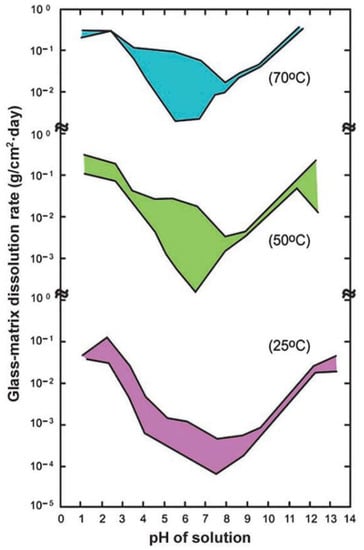
Figure 21.
Graphic illustration of the relationship between the initial dissolution rate of borosilicate glass and the temperature of each component of matrix [61,119].
Model experiments [120,121,122,123,124] show that the initial solubility rate of borosilicate panes at temperatures around 100 °C in neutral solutions is in the order of 10−3–10−2 g/cm2 days and increases as pH increases by a power law (roughly proportional to 100.4pH) [61].
4.3.2. Dissolution of Sodium-Aluminophosphate Glass, Which Is the Material of Vitrified HLW under the Exposure of Groundwater Contacting Cement, as a Material of Engineered Safety Barrier
The rate of dissolution of Russian sodium phosphate glass at room temperatures by the most soluble components (type Na) does not exceed 10−4–10−5 g/cm2·days, however, when water vapour is heated in the atmosphere, it is quickly opened with a leaching rate of up to three orders of magnitude and the transition of many impurity elements such as radionuclides to colloid form. As a result, sodium-aluminophosphate glass can be inferior to borosilicate glass under typical conditions in geological disposal facility [61].
Experiments with solutions whose salt composition is close to real groundwater have shown a reduction in the solubility rate of glass by about two orders of magnitude compared to solutions with low salt content [61].
For glass that has been in the environment for thousands of years, examination of the profiles of the altered surface has shown that the real dissolve rate of the glass is always lower than that of the existing models [61].
Preliminary estimates show that the increase in the dilution rate of glass is not a determining factor, and its increase even by three orders of magnitude is not critical for the safety of geological disposal facility under the normal operation of other barriers. However, this issue needs to be further elaborated [61].
It can be concluded that the main changes in the properties of the elements of engineered barrier system that are in direct contact with concrete are listed in Table 8 and mainly determined due to the impact of a highly alkaline concrete pore solution.

Table 8.
Transformation of engineered barrier system components under alkaline concrete pore solution exposure.
5. Mutual Transformations of Concrete-Bentonite under Exposure of Granitic Host Rock Groundwater
The study of geochemical processes occurring in the engineered barrier system is an important part of the geological disposal facility design and following modelling of long-term evolution of engineered barriers. The results of this study mainly contain mineralogical and chemical changes of barrier materials and determined by transport of dissolved mineral components of the host rock and engineered barriers in groundwater. Full-scale and short-term experimental results and their comparison are necessary to analyze how selected engineered barriers act on each other at their interface in geological disposal facility conditions. Since concrete and bentonite are common in most concept designs of geological disposal facilities and their interactions are key factors determining secure isolation of radioactive waste.
5.1. Mutual Influence of Engineered Barrier Materials in the «Concrete-Bentonite» System under the Exposure of Groundwater in the Long Term Experiments
A unique and oldest long-term in situ experiment was performed in Grimsel Test Site (GTS) underground research laboratory. Since this experiment involved the detailed study of compacted bentonite buffer and concrete plug interaction, it will be particularly described below.
The Grimsel Test Site, located in the Swiss Alps, was founded in 1984 as a facility for underground research projects related to the geological disposal facility of radioactive waste in granite host rock. The FEBEX (Full-scale Engineered Barrier Experiment) experiment is a full-scale study of engineered barriers under natural conditions [6].
The horizontal tunnel, 70 m long and 2.28 m in diameter, was drilled in granite rocks crossed by a lamprophyre layer, in which 2 electric heaters simulating heat release from high-level waste canisters (4.5 m long and 0.9 m diameter) were placed 1 m apart and surrounded by the FEBEX bentonite barrier, 0.7 m thick (Figure 22). However, after five years of uninterrupted use of the heaters, one of them, located closest to the concrete plug of the gallery, was disconnected, removed along with the bentonite and plug surrounding it, replaced with a steel dummy 1 m long. It was re-surrounded by bentonite blocks and a new concrete plug was made. It consists of two layers and was manufactured using the technology of spraying cement mortar directly into the gallery (shotcreting). The first layer of the 1 m thick plug is in direct contact with bentonite and steel chump, and the second layer is 2 m long. Between these layers, a 3–4 cm thick moisture-resistant polymer layer is constructed. After replacing one of the heaters with a steel dummy, the experiment was resumed and continued for 13 years [6].

Figure 22.
Longitudinal section of the FEBEX setup and location of drilled concrete cores [6].
5.1.1. Concrete-Bentonite Mineral Surfaces Passivation and Formation of Crystalline Phases in the Concrete Pores by Means of Groundwater Exposure
Ca2+ content in pore solution of concrete is controlled mainly by dissolution of Portlandite, but closer to the concrete/bentonite interface it may be due to deposition of calcite and gypsum. The presence of gypsum was found in a bentonite layer <1 mm thick, located on the contact surface with concrete, in which the carbonate content was lower than gypsum [13]. The redistribution of δ13C isotopes in bentonite carbonates has also been determined, showing the redistribution of the calcite from the bentonite volume to the concrete surface at the point of contact [6].
Mg is precipitated on the concrete surface as stevensite-like phases, as their formation requires high pH (~10) and high Na content, which diffuses from concrete [13].
The mapping of secondary electrons (by means of SEM-EDX) on the scanning electron microscope of the concrete plug sample from the upper core yielded clear effects of ettringite formation from the detected area of its concentration on the concrete surface in contact with bentonite. The presence of a set of ettringite crystals was also detected by SEM [6,13]. The formation of ettringite is mainly due to sulphate-anion diffusion. However, in the manufacturing of a concrete plug, shotcrete additives were used to accelerate its grasping at a maximum of 6% mass which subsequently increased the aluminum content [6].
5.1.2. Transport of Ions in the Concrete-Bentonite Interface (Transfer of Mg2+ Ions, SO42− from Bentonite to Concrete and Ca2+, Na+, K+ from Concrete to Bentonite) under the Action of Groundwater (Transfer of Cl− and HCO3− Ions Dissolved in Groundwater)
Granite groundwater Grimsel Test Site has a very low ionic force, its pH is approximately 9, and it is the main factor for diffusion of soluble components of concrete and subsequent reduction of pH solution in its pores. pH in the central core (Figure 22) is measured at different distances from the steel dummy and its value in any part is always above 12.65, despite its slightly reduced value at a distance of 1 cm from the dummy. At a distance of 2 cm pH was found to be 12.8. However, the upper and lower cores (Figure 22) have a lower pH, up to a distance of 5 cm from the bentonite barrier and its value measured in the lower region are slightly lower than the upper one. After measurements, pH was determined to be less than 12.2 (even 12 in the lower case) at a distance of 1 cm from the bentonite barrier. The pH decrease is a consequence of several processes, the main of which is the leaching of alkali metal ions (Na and K) with the accompanying dissolution of portlandite (Ca(OH)2). It is widely known that at pH below 12.5, the presence of portlandite is limited or absent from the concrete structure [6].
Moreover, the main water-soluble ions in the concrete near the interface (Na, K, Ca, SO42−, Cl) have different concentrations in the central core relative to the upper and lower. The measurements of their average content in the central core were taken at a distance of 1 cm and 5 cm from the steel dummy and have almost identical values. Results from the upper and lower cores suggest that water sources interacting with concrete have a joint influence on its composition. First of all, a decrease in the content of alkali metals (and Na and K) in the upper and lower cores of the concrete plug, compared to its central part, was determined. This was determined to have been caused by granite groundwater. However, the calcium content is higher in the upper and lower cores compared to the central, which is mainly due to the transfer of Ca2+ ions from bentonite at the time it is saturated with granite groundwater, when there is a redistribution of ions between the cation exchange links in the bentonite structure and groundwater. Therefore, the FEBEX bentonite water is enriched with Ca2+ ions. Thus, Ca diffuses from the bentonite pore solution to the concrete pore solution and this phenomenon plays an important role in explaining the results.
The interaction of bentonite pore water with concrete is further confirmed by analyses of dissolved sulfates and chlorides in the upper and lower cores of the concrete plug, at the interface with bentonite. Both anions are represented in lower and upper samples at a distance close to the interface of bentonite with concrete, but their content is very low in the central core at the same distances (due to lack of direct contact with bentonite pore or granite groundwater). While Cl penetrates faster, even up to 5 cm from bentonite, high sulphate content is only found on the first centimeter of concrete from the bentonite surface [6].
Granite groundwater in Grimsel Test Site has a fairly low salt content (total dissolved < 10 mg/L), caused mainly by Na-Ca-HCO3 (pH~9). The deposition of calcite on the contact surface of bentonite concrete confirms the transfer of HCO3− ions from groundwater through the concrete cap [6].
5.1.3. Alteration of the Mechanical Properties of Concrete at Concrete/Bentonite Interface Due to Groundwater Characteristic of the Host Rock
In the work [6], the initial compressive strength value of concrete in the plug was obtained was 32 MPa. After 13 years of operation, the compressive strength of the upper concrete core became 30.5 ± 3.9 MPa, 30.2 ± 3.8 MPa of the central and 29.9 ± 2.2 MPa of the lower. Thus, a slight decrease in the strength of concrete can be a consequence of its aging. Consequently, changes in the microstructure of concrete are not yet limited by its mechanical strength, although the mechanical strength of concrete at the point of contact with bentonite cannot be measured [6].
5.2. Mutual Influence of Engineered Barrier Materials in the «Concrete-Bentonite» System under the Exposure of Synthetic Groundwater in the S Term Experiments
On the basis of the obtained data sets at Grimsel Test Site, in articles [11,12] the method of laboratory experiment simulating conditions in Grimsel Test Site was developed. To achieve this, a laboratory unit was developed, the device of which is shown in Figure 23.
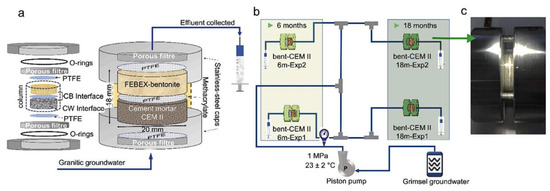
Figure 23.
Arrangement of transport cells: (a) cell structure; (b) experimental setup; (c) photo of concrete/bentonite interface in of one cell [13].
Concrete and bentonite FEBEX (compacted to dry density 1.5 g/cm3) are placed in the housing, which is a methacrylate hollow cylinder closed by two steel flanges, which give the cell a stiffness of the structure, and separated by a polytetrafluoroethylene (PTFE) membrane with a pore thickness of 0.45 µm. The cell has an internal diameter of 20 mm and a height of 18 mm (9 mm per cement layer and bentonite layer). The cell was designed in such a way that it could be easily disassembled for further analysis of the solid phase changes and the concrete and bentonite could be easily removed from the cell. The design of the cell prevents deformation of concrete and bentonite inside the housing, drying of both materials and isolates from air ingress. The compact outer casing made of stainless steel (together with joints and filters) is able to withstand the high pressure caused by the swelling of bentonite. According to the conditions in the Grimsel Test Site, granite underground water is injected at a constant pressure of 1 MPa through tubes of polyetheretherketone (PEEK) using an automatic piston pump. The elute is collected at the outlet of bentonite and then its volume is measured [11].
Two transport cells are launched for 6 months, and the other two are 18-inch, in virtually isolated laboratory conditions (23 ± 2 °C). The conditions are similar to the expected temperature of the concrete-bentonite system according to the data obtained by the Grimsel Test Site during the FEBEX [12] experiment.
Underground granite water of Grimsel Test Site has the electric conductivity value of 104 μSm/cm, pH = 8.1 and the following composition (mg/L): Cl− (3.5), SO42− (9.6), HCO3− (42.7), Na+ (11.5), K+ (<0.1), Ca2+ (12.0) and Mg2+ (<0.1) [11].
Papers [11,12] present an assessment of the geochemical reactions occurring at the concrete-bentonite interface at the early stages of their interaction in order to compile the most complete picture of the processes occurring in the course of large-scale and long-term experiments. The results obtained in the course of a full-scale experiment at the Grimsel test site and a short-term experiment in the works [11,12] are consistent and can be summarized as follows:
- Decalcification of C-S-H in a medium in which portlandite dissolves and progressive hydration of anhydrous phases occurs.
- Development of a film of calcite on the interface of concrete with bentonite and dispersed precipitation of calcite in localized zones of bentonites.
- The beginning of the development of Mg-containing components on the interface of bentonite with concrete, associated with the formation of Mg-clay 2:1 sheet silicates as the main neogenic phases expected in the long term.
- Formation of secondary ettringite in concrete at the interface with bentonite.
Thus, the short-term experiment in [11,12] is promising when used to study the interaction of barrier materials, coupled with the use of mathematical modeling of the ongoing processes for their extrapolation to long-term time intervals.
6. Conclusions
This article provides a general review of the concepts of radioactive waste geological disposal facilities/deep geological repositories in terms of the function performed by engineered barriers based on cement, laboratory experiments involving cement materials individually, and when they come into contact with other elements of the engineered barrier systems directly and as products of interaction with model solutions of groundwater. In view of the emerging uncertainty in the concept of the organization of GDF in the Russian Federation, it is necessary to focus on the results of existing concepts, on the actual conditions in prospective geological formations and on the existing requirements for the disposal of radioactive waste. Furthermore, for a number of selected promising concretes, it is necessary to conduct a full cycle of both laboratory and long-term research under engineered barrier conditions with individual analysis of both physical–chemical and operational properties of cement materials, and the mutual influence of all engineered barrier materials. Thus, at the stage of laboratory experiments, it is necessary to determine the filtration coefficients (hydraulic permeability) of concrete and cores of containing rock from the Yeniseysky site in comparison; the selected concrete should have a value lower than for the rock. When selecting a potential concrete as the engineered barrier, the influence of its dissolved components in aqueous environments on the bentonite buffer properties (if the current concept provides for direct contact or indirect contact of the concrete–-bentonite phases) and corrosion of stainless steel, often used as material for radioactive waste containers (in the case of cement buffers).
Author Contributions
Conceptualization, E.A.T. and V.V.K.; methodology, E.A.T.; software, P.P.K.; validation, E.A.T., P.P.K. and V.V.K.; formal analysis, P.P.K.; investigation, E.A.T.; resources, P.P.K.; data curation, V.V.K.; writing—original draft preparation, P.P.K.; writing—review and editing, E.A.T.; visualization, V.V.K.; supervision, E.A.T.; project administration, V.V.K. All authors have read and agreed to the published version of the manuscript.
Funding
This work was supported by the Russian Science Foundation Project No. 22-29-0067 «Developing of silver-containing bentonite-based sorbent for uptake of anionic forms of radioactive iodine in radioactive waste repositories».
Data Availability Statement
Not applicable.
Conflicts of Interest
The authors declare no conflict of interest.
Abbreviations
| µ-CT | Computer microtomography |
| C/B | Concrete-Bentonite interface |
| C/W | Concrete-Water interface |
| CEC | Cation Exchange Capacity |
| DGR | Deep Geologic Repository |
| EBS | Engineered Barrier System |
| EDX | Energy-Dispersive X-Ray Spectroscopy |
| ESB | Engineered Safety Barrier |
| FEBEX | Full-Scale Engineered Barrier Experiment |
| GTS | Grimsel Test Site |
| GW | Groundwater |
| HLW | High-Level Waste |
| IUPAC | International Union of Pure and Applied Chemistry |
| LL | Long-Lived |
| LLW | Low-Level Waste |
| LRW | Liquid Radioactive Waste |
| NPP | Nuclear Power Plant |
| NRVB | Nirex Reference Vault Backfill |
| NSDF | Near-Surface Disposal Facility |
| NSR | Near-Surface Repository |
| OPC | Ordinary Portland Cement |
| PEEK | Polyetheretherketone |
| pH | Hydrogen index |
| RW | Radioactive Waste |
| SEM | Scanning Electron Microscopy |
| SL | Short-Lived |
| SNF | Spent Nuclear Fuel |
| SNFA | Spent Nuclear Fuel Assembly |
| SSA | Specific Surface Area |
| STIMAN | Structural Image Analysis |
| TEM | Transmission Electron Microscopy |
| TRU | Transuranic |
| W/C | Water-Cement ratio |
References
- Ojovan, M.I.; Steinmetz, H.J. Approaches to Disposal of Nuclear Waste. Energies 2022, 15, 7804. [Google Scholar] [CrossRef]
- Olszewska, W.; Miśkiewicz, A.; Zakrzewska-Kołtuniewicz, G.; Lankof, L.; Pająk, L. Multibarrier system preventing migration of radionuclides from radioactive waste repository. Nukleonika 2015, 60, 557–563. [Google Scholar] [CrossRef]
- Disposal of Radioactive Waste for Protecting People and the Environment. No. SSR-5 Specific Safety Requirements. Available online: https://www-pub.iaea.org/MTCD/publications/PDF/Pub1449_web.pdf (accessed on 26 October 2022).
- Geological Disposal Facilities for Radioactive Waste for Protecting People and the Environment. No. SSG-14 Specific Safety Guide. Available online: https://www-pub.iaea.org/MTCD/Publications/PDF/Pub1483_web.pdf (accessed on 26 October 2022).
- Kozlov, P.V.; Gorbunova, O.A. Cementing as a Method of Radioactive Waste Immobilization; Mayak PA: Ozersk, Russia, 2011; 143p, ISBN 978-5-903159-30-7. [Google Scholar]
- Alonso, M.C.; Calvo, J.L.G.; Cuevas, J.; Turrero, M.J.; Fernández, R.; Torres, E.; Ruiz, A.I. Interaction processes at the concrete-bentonite interface after 13 years of FEBEX-Plug operation. Part I: Concrete alteration. Phys. Chem. Earth 2017, 99, 38–48. [Google Scholar] [CrossRef]
- Margeanu, C.A. Overview on the Multinational Collaborative Waste Storage and Disposal Solutions. 2012, p. 404. Available online: https://inis.iaea.org/search/search.aspx?orig_q=RN:45099892 (accessed on 26 October 2022).
- Drace, Z.; Mele, I.; Ojovan, M.I.; Rahman, R.A. An Overview of Research Activities on Cementitious Materials for Radioactive Waste Management; Cambridge University Press: Cambridge, UK, 2012; Volume 1475. [Google Scholar]
- IAEA. Performance of Engineered Barrier Materials in Near Surface Disposal Facilities for Radioactive Waste; TECDOC-1255; IAEA: Vienna, Austria, 2001; Available online: https://www-pub.iaea.org/MTCD/publications/PDF/te_1255_prn.pdf (accessed on 26 October 2022).
- Drace, Z.; Ojovan, M.I. The Behaviors of Cementitious Materials in Long Term Storage and Disposal: An Overview of the Results of the IAEA Ordinated Research Project; Cambridge University Press: Cambridge, UK, 2011. [Google Scholar]
- González-Santamaria, D.E.; Fernández, R.; Ruiz, A.I.; Ortega, A.; Cuevas, J. Bentonite/CEM-II cement mortar interface experiments: A proxy to in situ deep geological repository engineered barrier system surface reactivity. Appl. Geochem. 2020, 117, 104599. [Google Scholar] [CrossRef]
- González-Santamaria, D.E.; Fernández, R.; Ruiz, A.I.; Ortega, A.; Cuevas, J. High-pH/low pH ordinary Portland cement mortars impacts on compacted bentonite surfaces: Application to clay barriers performance. Appl. Clay Sci. 2020, 193, 105672. [Google Scholar] [CrossRef]
- Fernández, R.; Torres, E.; Ruiz, A.I.; Cuevas, J.; Alonso, M.C.; Calvo, J.L.G.; Rodríguez, E.; Turrero, M.J. Interaction processes at the concrete-bentonite interface after 13 years of FEBEX-Plug operation. Part II: Bentonite contact. Phys. Chem. Earth Parts A/B/C 2017, 99, 49–63. [Google Scholar] [CrossRef]
- Johannesson, L.E.; Börgesson, L.; Goudarzi, R.; Sandén, T.; Gunnarsson, D.; Svemar, C. Prototype repository: A full scale experiment at Äspö HRL. Phys. Chem. Earth Parts A/B/C 2007, 32, 58–76. [Google Scholar] [CrossRef]
- Johansson, E.; Siren, T.; Hakala, M.; Kantia, P. ONKALO POSE Experiment. Phase 1 and 2: Execution and Monitoring. 2014. Available online: https://inis.iaea.org/search/search.aspx?orig_q=RN:46094985 (accessed on 9 September 2021).
- Drace, Z.; Ojovan, M.I. The Behaviors of Cementitious Materials in Long Term Storage and Disposal of Radioactive Waste Results of a Coordinated Research Project; International Atomic Energy Agency: Vienna, Austria, 2013; Available online: https://www.cambridge.org/core/journals/mrs-online-proceedings-library-archive/article/abs/behaviours-of-cementitious-materials-in-long-term-storage-and-disposal-an-overview-of-results-of-the-iaea-coordinated-research-project/7F7F418E4419269494BD049B1DD6606A (accessed on 9 September 2021).
- Cementing Liquid Radioactive Waste. Available online: https://inis.iaea.org/collection/NCLCollectionStore/_Public/36/030/36030790.pdf (accessed on 9 September 2021).
- International Atomic Energy Agency. Conditioning of Low- and Intermediate-Level Radioactive Wastes; International Atomic Energy Agency (IAEA): Vienna, Austria, 1983. [Google Scholar]
- International Atomic Energy Agency. Improved Cement Solidification of Low and Intermediate Level Radioactive Wastes; Technical Reports Series No. 350; IAEA: Vienna, Vienna, 1993. [Google Scholar]
- Varlakov, A.P.; Zherebtsov, A.A.; Germanov, A.V.; Maryahkin, M.A.; Krapivina, M.K. Raw Conditioning Using Special Cements And Hot Pressing Method. In Proceedings of the X Russian Conference with International Participation “Radiochemistry-2022”, Saint-Petersburg, Russia, 26–30 September 2022; p. 401. [Google Scholar]
- Varlakov, A.P.; Germanov, A.V.; Maryakhin, M.A.; Varlakova, G.A.; Krapivina, M.K.; Zherebtsov, A.A.; Petrov, V.G.; Kalmykov, S.N. Influence of irradiation on the properties of the cement compound as a matrix for curing high-level wastes. At. Energy 2021, 130, 218–222. [Google Scholar] [CrossRef]
- Zherebtsov, A.A.; Kapustin, V.V.; Varlakova, G.A.; Varlakov, A.P.; Petrov, V.G.; Vlasova, I.E.; Kharitonov, I.D.; Kalmykov, S.N. Chemical resistance and structural characteristics of cement compounds with radioactive waste simulators after exposure to ionizing radiation. At. Energy 2019, 127, 328–331. [Google Scholar]
- Sorokin, V.T.; Gataullin, R.M.; Sviridov, N.V.; Pavlov, D.I. Longevity of NZK-150-1.5P type reinforced concrete containers for class 2 radioactive waste disposal. Radioact. Waste 2022, 3, 37–49. [Google Scholar] [CrossRef]
- Preparatory Safety Assessment: Conceptual Model Description of the Reference Case, External Report, sck CEN-ER-215, 12/Ewe/P-42, September 2012. Available online: https://researchportal.sckcen.be/en/publications/preparatory-safety-assessment-conceptual-model-description-of-the (accessed on 15 October 2022).
- Tsebakovskaya, N.S.; Utkin, S.S.; Kapyrin, I.V.; Medyantsev, N.V.; Shamina, A.V. Review of Foreign Practices of SNF and RW Disposal; Linge, I.I., Yu, D., Polyakov, M., Eds.; Publishing House “Komtechprint”: Moscow, Russia, 2015; 208p. [Google Scholar]
- Corkhill, C.; Hyatt, N. Nuclear Waste Management; IOP Publishing: Bristol, UK, 2018. [Google Scholar]
- Collier, N.C.; Heyes, D.W.; Butcher, E.J.; Borwick, J.; Milodowski, A.E.; Field, L.P.; Kemp, S.J.; Mounteney, I.; Bernal, S.A.; Corkhill, C.L.; et al. Gaseous carbonation of cementitious backfill for geological disposal of radioactive waste: Nirex Reference Vault Backfill. Appl. Geochem. 2019, 106, 120–133. [Google Scholar] [CrossRef]
- Vasconcelos, R.G.W.; Beaudoin, N.; Hamilton, A.; Hyatt, N.C.; Provis, J.L.; Corkhill, C.L. Characterization of a high pH cement backfill for the geological disposal of nuclear waste: The Nirex Reference Vault Backfill. Appl. Geochem. 2018, 89, 180–189. [Google Scholar] [CrossRef]
- Crossland, I.G.; Vines, S.P. Why a Cementitious Repository? United Kingdom Nirex Limited 2001, Report N/034. 2001; 19p. Available online: https://rwm.nda.gov.uk/publication/why-a-cementitious-repository-nirex-report-n034-2001/ (accessed on 15 October 2022).
- Bamforth, P.B.; Baston, G.M.N.; Berry, J.A.; Glasser, F.P.; Heath, T.G.; Jackson, C.P.; Savage, D.; Swanton, S.W. Cement Materials for Use as Backfill, Sealing and Structural Materials in Geological Disposal Concepts. A Review of Current Status. Serco, United Kingdom, RP0618-252A. 2012. Available online: https://www.researchgate.net/profile/David-Savage-9/publication/261471551_Cement_materials_for_use_as_backfill_sealing_and_structural_materials_in_geological_disposal_concepts_A_review_of_current_status/links/00463534542beaa80b000000/Cement-materials-for-use-as-backfill-sealing-and-structural-materials-in-geological-disposal-concepts-A-review-of-current-status.pdf (accessed on 15 October 2022).
- Menéndez, G.; Bonavetti, V.; Irassar, E.F. Strength development of ternary blended cement with limestone filler and blast-furnace slag. Cem. Concr. Compos. 2003, 25, 61–67. [Google Scholar] [CrossRef]
- Watson, S.; Metcalfe, R.; Paulley, A.; McEwen, T.; Michie, U. Identification of How Aspects of Nirex PGRC Would Differ If Adapted to Alternative Geologies. Quintessa Report QRS-1338A-1. 2007. Available online: https://www.researchgate.net/profile/Tim-Mcewen/publication/265260401_Identification_of_How_Aspects_of_the_Nirex_PGRC_Would_Differ_if_Adapted_to_Alternative_Geologies/links/54de823d0cf2510fcee3e219/Identification-of-How-Aspects-of-the-Nirex-PGRC-Would-Differ-if-Adapted-to-Alternative-Geologies.pdf (accessed on 15 October 2022).
- Bogatov, S.A.; Kryuchkov, D.V.; Pavlov, D.I.; Sychenko, D.V. Analysis of Various Concepts for RW Class 1 Disposal in Crystalline Rocks. Radioact. Waste 2020, 3, 66–77. [Google Scholar] [CrossRef]
- Hungary National Report: Sixth Report Prepared within the Framework of the Joint Convention on the Safety of Spent Fuel Management and on the Safety of Radioactive Waste Management. Available online: https://www.iaea.org/sites/default/files/jc6thnationalreporthungary.pdf (accessed on 9 December 2022).
- Waste Acceptance System For Bátaapáti National Radioactive Waste Repository. Available online: https://gnssn.iaea.org/RTWS/general/Shared%20Documents/Waste%20Management/Feb%202015%20WS%20on%20LLW%20disposal/Day%202)%20Hungary.pdf (accessed on 15 October 2022).
- Morsleben–BGE. Available online: https://www.bge.de/en/morsleben/ (accessed on 13 September 2021).
- Safety: Anticipating the Risks|ANDRA. Available online: https://international.andra.fr/projects/cigeo/safety-anticipating-risks (accessed on 13 September 2021).
- Andra, D. Argile: Tome Architecture and Management of a Geological Repository; Andra Report C.RP.ADP.04.0001; Andra: Malabry, France, 2005. [Google Scholar]
- Types of Radioactive—NAGRA. Available online: https://www.nagra.ch/en/types.htm (accessed on 13 September 2021).
- NAGRA. Technical Report 21-01E. Waste Management Program 2021 of the Waste Producers. Available online: https://nagra.ch/wp-content/uploads/2022/08/NTB-21-01E.pdf (accessed on 25 October 2021).
- Nõs, B.; Molnár, P.; Baksay, A. Disposal of low and intermediate level waste in Hungary/Odlaganje otpada niskog i srednjeg stupnja radioaktivnsti u mađarskoj. Rud.-Geol.-Naft. Zb. 2012, 24, 81–85. [Google Scholar]
- High Level Waste—ENRESA. Available online: https://www.enresa.es/eng/index/activities-and-projects/cts (accessed on 14 September 2021).
- Gierszewski, P. Overview of Ontario Power Generation’s Proposed Deep Geologic Repository for Low & Intermediate Level Waste at the Bruce Site, Ontario, Canada-8517. 2008. Available online: https://archivedproceedings.econference.io/wmsym/2008/pdfs/8517.pdf (accessed on 15 October 2022).
- King, F.K. OPG’s deep geological repository for low and intermediate level waste-recent progress. In Proceedings of the TOPSEAL 2006 international topical meeting, Olkiliuoto, Finland, 17–20 September 2006. [Google Scholar]
- SFR—Final Repository for Short-Lived Radioactive Waste|SKB. Available online: https://skb.se/upload/publications/pdf/SFR_folder_engelsk.pdf (accessed on 15 September 2021).
- KBS-3H Seminar Was —Topics -NUMO Web Site. Available online: https://www.numo.or.jp/en/what/topics_170911.html (accessed on 15 October 2021).
- Loukusa, H.; Nordman, H. Feasibility of KBS-3 spent fuel disposal concept for Norwegian spent fuel. AINS Group Espoo. 2020. Available online: https://www.norskdekommisjonering.no/wp-content/uploads/2020/07/Technical-report-Feasability-of-KBS-3-spent-fuel-disposal-concept-for-Norwegian-fuel-20200615.pdf (accessed on 15 October 2022).
- Siren, T.; Hakala, M.; Valli, J.; Kantia, P.; Hudson, J.A.; Johansson, E. In situ strength and failure mechanisms of migmatitic gneiss and pegmatitic granite at the nuclear waste disposal site in Olkiluoto, Western Finland. Int. J. Rock Mech. Min. Sci. 2015, 79, 135–148. [Google Scholar] [CrossRef]
- Pettersson, S.; Loennerberg, B. Final Repository for Spent Nuclear Fuel in Granite-the KBS-3V Concept in Sweden and Finland. 2008. Available online: https://inis.iaea.org/search/search.aspx?orig_q=RN:41025036 (accessed on 15 October 2022).
- Börgesson, L. KBS-3H Summary Report: Design of Buffer and Filling Components; Svensk Kärnbränslehantering AB—Swedish Nuclear Fuel and Waste Management Company: Stockholm, Sweden, 2017. [Google Scholar]
- Mathern, A.; Flansbjer, M.; Löfgren, I.; Magnusson, J. Experimental study of time-dependent properties of a low-pH concrete for deposition tunnels. In Proceedings of the International Federation for Structural Concrete 5th International Fib Congress, Melbourne, Australia, 7–11 October 2018; Volume 7, p. 11. [Google Scholar]
- Hakanen, M.; Ervanne, H. The Influence of Organic Cement Additives on Radionuclide Mobility A Literature Survey (POSIVA-WR--06-06), Finland. 2006. Available online: https://www.semanticscholar.org/paper/The-Influence-of-Organic-Cement-Additives-on-Hakanen-Ervanne/7367ec0c3d801844195fddde6af769b1360636da (accessed on 15 October 2022).
- García, D.; Grivé, M.; Duro, L.; Brassinnes, S.; de Pablo, J. The potential role of the degradation products of cement superplasticizers on the mobility of radionuclides. Appl. Geochem. 2018, 98, 1–9. [Google Scholar] [CrossRef]
- Vogt, C. Full-Scale Test of the Dome Plug for KBS-3V Deposition Tunnels—Concrete Properties; Svensk Kärnbränslehantering AB: Stockholm, Sweden, 2019. [Google Scholar]
- Malm, R.; Enzell, J.; Hassanzadeh, M. Full-Scale Test of the Dome Plug for KBS-3V Deposition Tunnels–Structural Response of the Concrete Dome; Svensk Kärnbränslehantering AB: Stockholm, Sweden, 2019. [Google Scholar]
- Enzell, J.; Malm, R. Full-Scale Test of the Dome Plug for KBS-3V Deposition Tunnels; Project Summary and Evaluation of the Final Results; Svensk Kärnbränslehantering AB: Stockholm, Sweden, 2019. [Google Scholar]
- Geological Disposal Concepts—Operation—NUMO Website. Available online: https://www.numo.or.jp/en/jigyou/geological.html (accessed on 15 September 2021).
- NUMO. The NUMO Pre-Siting SDM-Based Safety Case; Report NUMO-TR-21-01; Nuclear Waste Management Organization of Japan: Tokyo, Japan, 2021. [Google Scholar]
- Blokhin, A.I.; Blokhin, P.A.; Kazieva, S.T. Application of the TRACT calculation code for assessment of radionuclide compositions and radiation characteristics of SNF and RW of class 1. Radioact. Waste 2020, 13, 99–111. [Google Scholar] [CrossRef]
- Tyupina, E.A.; Pryadko, A.V.; Merkushkin, A.O. Method for obtaining a silver-containing sorbent based on bentonite for fixing radioiodine compounds. Sorpt. Chromatogr. Process. 2021, 21, 26–32. [Google Scholar] [CrossRef]
- Bogatov, S.A. HLW Disposal of in Verticale Deposition Holes with Cement Backfill—Pro and Contra with Regard to Long Term Safety of Geological Disposal Facility. Radioact. Waste 2018, 1, 21–33. (In Russian) [Google Scholar]
- Dickinson, M.; Holton, D.; Bamforth Ph Cairns, M. Development of Understanding of Disposability of High-Heat-Generating Wastes in the UK. WMS J. 2015, 1, 13. [Google Scholar]
- Khoury, G.A. Effect of fire on concrete and concrete structures. Prog. Struct. Eng. Mater. 2000, 2, 429–447. [Google Scholar] [CrossRef]
- Naus, D.J. A Compilation of Elevated Temperature Concrete Material Property Data and Information for Use in Assessments of Nuclear Power Plant Reinforced Concrete Structures; Report ORNL/TM-20009/175; Oak Ridge National Laboratory: Oak Ridge, TN, USA, 2010; 328p. [Google Scholar]
- Calvo, J.L.G.; Hidalgo, A.; Alonso, C.; Luco, L.F. Development of low-pH cementitious materials for HLRW repositories: Resistance against ground water aggression. Cem. Concr. Res. 2010, 40, 1290–1297. [Google Scholar] [CrossRef]
- Morozov, I.; Zakusin, S.; Kozlov, P.; Zakusina, O.; Roshchin, M.; Chernov, M.; Boldyrev, K.; Zaitseva, T.; Tyupina, E.; Krupskaya, V. Bentonite–Concrete Interactions in Engineered Barrier Systems during the Isolation of Radioactive Waste Based on the Results of Short-Term Laboratory Experiments. Appl. Sci. 2022, 12, 3074. [Google Scholar] [CrossRef]
- Rozov, K.B.; Rumynin, V.G.; Nikulenkov, A.M.; Leskova, P.G. Sorption of 137Cs, 90Sr, Se, 99Tc, 152 (154) Eu, 239 (240) Pu on fractured rocks of the Yeniseysky site (Nizhne-Kansky massif, Krasnoyarsk region, Russia). J. Environ. Radioact. 2018, 192, 513–523. [Google Scholar] [CrossRef]
- Meleshyn, A.Y.; Zakusin, S.V.; Krupskaya, V.V. Swelling pressure and permeability of compacted bentonite from 10th khutor deposit (Russia). Minerals 2021, 11, 742. [Google Scholar] [CrossRef]
- Plusquellec, G.; Geiker, M.R.; Lindgård, J.; Duchesne, J.; Fournier, B.; De Weerdt, K. Determination of the pH and the free alkali metal content in the pore solution of concrete: Review and experimental comparison. Cem. Concr. Res. 2017, 96, 13–26. [Google Scholar] [CrossRef]
- Vollpracht, A.; Lothenbach, B.; Snellings, R.; Haufe, J. The pore solution of blended cements: A review. Mater. Struct. 2016, 49, 3341–3367. [Google Scholar] [CrossRef]
- Duchesne, J.; Reardon, E.J. Measurement and prediction of portlandite solubility in alkali solutions. Cem. Concr. Res. 1995, 25, 1043–1053. [Google Scholar] [CrossRef]
- Jenni, A.; Mäder, U.; Lerouge, C.; Gaboreau, S.; Schwyn, B. In situ interaction between different concretes and Opalinus Clay. Phys. Chem. Earth Parts A/B/C 2014, 70–71, 71–83. [Google Scholar] [CrossRef]
- Varlakov, A.P.; Kapustin, V.V.; Varlakova, G.A.; Zherebtsov, A.A.; Petrov, V.G.; Shirshin, E.A.; Kalmykov, S.N. The Effect of Radiation Doses Typical for High-level Waste on the Poperties of the Cement Matrix. Radioact. Waste 2018, 1, 63–68. [Google Scholar]
- GOST R 50926-96. Highly Active Solidified Waste. General Technical Requirements. 18 July 1996. Available online: https://www.russiangost.com/p-48099-gost-r-50926-96.aspx (accessed on 15 October 2022).
- Safonov A, V.; Boldyrev, K.A. URL In the Nizhnekanskiy Massif: Studying Biogenic Processes Under HLW Disposal Project. Radioact. Waste 2019, 2, 92–100. [Google Scholar] [CrossRef]
- Safonov, A.V.; Gorbunova, O.A.; German, K.E.; Zakharova, E.V.; Tregubova, V.E.; Ershov, B.G.; Nazina, T.N. Microbiological Aspects of Radioactive Waste Storage. Radiatsionnaia Biol. Radioecol. 2015, 55, 293–301. [Google Scholar] [CrossRef]
- Gorbunova, O.A. Prevention of Biogenic Destruction and Improvement of the Quality of the Cement Matrix Immobilizing Radioactive Waste: Abstract of the Thesis. Dis. Doctor of Technical Sciences: 05.17.11, 25.00.36/Gorbunova Olga Anatolyevna; FSUE “Radon”. 2012. 32p. Available online: https://static.freereferats.ru/_avtoreferats/01005089405.pdf (accessed on 20 October 2022).
- Gorbunova, O.A. Influence of microbiological destruction of the cement matrix on the safety of long-term storage of conditioned radioactive waste. Fiz. Khim. Obrab. Mate 2011, 4, 98–106. [Google Scholar]
- Ershov, B.G.; Safonov, A.V.; Nazina, T.N.; Gorbunova, O.A. Influence of Microbiological Processes on the Safety of Radioactive Waste Management. Safety of Nuclear Technologies and the Environment No. 1 2012: “NFC Closure”. Available online: http://www.atomic-energy.ru/technology/39922 (accessed on 20 October 2022).
- Kamorny, D.A.; Safonov, A.V.; Boldyrev, K.A.; Abramova, E.S.; Tyupina, E.A.; Gorbunova, O.A. Modification of the Cement Matrix with Organic Additives for Stabilizing Pertechnetate Ions. J. Nucl. Mater. 2021, 557, 153295. [Google Scholar] [CrossRef]
- Krupskaya, V.V.; Zakusin, S.V.; Lekhov, V.A.; Dorzhieva, O.V.; Belousov, P.E.; Tyupina, E.A. Buffer properties of bentonite barrier systems for radioactive waste isolation in geological repository in the Nizhnekanskiy Massif. Radioact. Waste 2020, 1, 35–55. [Google Scholar] [CrossRef]
- Sellin, P.; Leupin, O.X. The use of clay as an engineered barrier in radioactive–waste management—A review. Clay Clay Miner. 2013, 61, 477–498. [Google Scholar] [CrossRef]
- Dixon, D.; Sandén, T.; Jonsson, E.; Hansen, J. Backfilling of Deposition Tunnels: Use of Bentonite Pellets. SKB P-11-44. 2011. 46p. Available online: http://www.skb.com/publication/2308782/P-11-44.pdf (accessed on 20 October 2022).
- Boerjesson, L.; Gunnarsson, D.; Johannesson, L.E.; Jonsson, E. Design, Production and Initial State of the Buffer; Technical Report, SKB 2010. TR-10-15; Svensk Kärnbränslehantering AB: Stockholm, Sweden, 2010; 89p. [Google Scholar]
- Wersin, P.; Johnson, L.H.; McKinley, I.G. Performance of the bentonite barrier at temperatures beyond 100 C: A critical review. Phys. Chem. Earth Parts A/B/C 2007, 32, 780–788. [Google Scholar] [CrossRef]
- Fries, T.; Claudel, A.; Weber, H.; Johnson, L.; Leupin, O. The Swiss concept for the disposal of spent fuel and vitrified HLW. Intern. In Proceedings of the Underground Disposal Unit Design & Emplacement Processes for a Deep Geological Repository, Prague, Czech Republic, 16–18 June 2008; Available online: http://library.sinap.ac.cn/db/fangshexing201103//41025019.pdf (accessed on 20 October 2022).
- Kaufhold, S.; Dohrmann, R. Distinguishing between more and less suitable bentonites for storage of high-level radioactive waste. Clay Miner. 2016, 51, 289–302. [Google Scholar] [CrossRef]
- Kale, R.C.; Ravi, K. Influence of thermal loading on index and physicochemical properties of Barmer bentonite. Appl. Clay Sci. 2018, 165, 22–39. [Google Scholar] [CrossRef]
- Pusch, R. Permeability of Highly Compacted Bentonite; no. SKBF/KBS-TR--80-16; Svensk Kärnbränslehantering AB: Stockholm, Sweden, 1980. [Google Scholar]
- Pusch, R. Swelling Pressure of Highly COMPACTED bentonite; no. SKBF/KBS-TR--80-13; Svensk Kärnbränslehantering AB: Stockholm, Sweden, 1980. [Google Scholar]
- Pusch, R. Use of bentonite for isolation of radioactive waste products. Clay Miner. 1992, 27, 353–361. [Google Scholar] [CrossRef]
- Komine, H.; Ogata, N. Prediction for swelling characteristics of compacted bentonite. Can. Geotech. J. 1996, 33, 11–22. [Google Scholar] [CrossRef]
- Lloret, A.; Villar, M.V.; Sanchez, M.; Gens, A.; Pintado, X.; Alonso, E.E. Mechanical behavior of heavily compacted bentonite under high suction changes. Géotechnique 2003, 53, 27–40. [Google Scholar] [CrossRef]
- Tan, Ö.; Yılmaz, L.; Zaimoğlu, A.S. Variation of some engineering properties of clays with heat treatment. Mater. Lett. 2004, 58, 1176–1179. [Google Scholar] [CrossRef]
- Garcia Garcia, S. The Impact of Groundwater Chemistry on the Stability of Bentonite Colloids. Ph.D. Thesis, KTH, Stockholm, Sweden, 2007. [Google Scholar]
- García-García, S.; Jonsson, M.; Wold, S. Temperature effect on the stability of bentonite colloids in water. J. Colloid Interface Sci. 2006, 298, 694–705. [Google Scholar] [CrossRef]
- Geneste, P.; Raynal, M.; Atabek, R.; Dardaine, M.; Oliver, J. Characterization of a French clay barrier and outline of the experimental program. Eng. Geol. 1990, 28, 443–454. [Google Scholar] [CrossRef]
- Alonso, E.E.; Vaunat, J.; Gens, A. Modeling the mechanical behavior of expansive clays. Eng. Geol. 1999, 54, 173–183. [Google Scholar] [CrossRef]
- Cui, Y.J.; Yahia-Aissa, M.; Delage, P. A model for the volume change behavior of heavily compacted swelling clays. Eng. Geol. 2002, 64, 233–250. [Google Scholar] [CrossRef]
- Krupskaya, V.V.; Zakusin, S.V.; Tyupina, E.A.; Dorzhieva, O.V.; Chernov, M.S.; Bychkova, Y.V. Transformation of structure and adsorption properties of montmorillonite under thermochemical treatment. Geochem. Int. 2019, 57, 314–330. [Google Scholar] [CrossRef]
- Krupskaya, V.V.; Zakusin, S.V.; Tyupina, E.A.; Dorzhieva, O.V.; Zhukhlistov, A.P.; Belousov, P.E.; Timofeeva, M.N. Experimental study of montmorillonite structure and transformation of its properties under treatment with inorganic acid solutions. Minerals 2017, 7, 49. [Google Scholar] [CrossRef]
- Milyutin, V.V.; Nekrasova, N.A.; Belousov, P.E.; Krupskaya, V.V. Sorption of Radionuclides 137Cs, 90Sr, and 233U on Various Natural Sorbents. Radiochemistry 2021, 63, 741–746. [Google Scholar] [CrossRef]
- Krupskaya, V.V.; Biryukov, D.V.; Belousov, P.E.; Lekhov, V.A.; Romanchuk, A.Y.; Kalmykov, S.N. Use of natural clay materials to increase nuclear and radiation safety of nuclear legacy facilities. Radioact. Waste 2018, 2, 30–43. [Google Scholar]
- Torstenfelt, B.; Allard, B.; Andersson, K.; Kipatsi, H.; Eliasson, L.; Olofsson, U.; Persson, H. Radionuclide Diffusion and Mobility in Compacted Bentonite; no. SKBF-KBS-TR--83-34; Swedish Nuclear Fuel Supply Co.: Göteborg, Sweden, 1983. [Google Scholar]
- Karnland, O.; Olsson, S.; Nilsson, U. Mineralogy and Sealing Properties of Various Bentonites and Smectite-Rich Clay Materials; Technical Report TR 06-30; Svensk Kärnbränslehantering AB: Stockholm, Sweden, 2006; 112p, Available online: http://www.skb.se/upload/publications/pdf/TR-06-30.pdf (accessed on 20 October 2022).
- Marty, N.C.M.; Claret, F.; Lassin, A.; Tremosa, J.; Blanc, P.; Made, B.; Giffaut, E.; Cochepin, B.; Tournassat, C. A database of dissolution and precipitation rates for clay-rocks minerals. Appl. Geochem. 2015, 55, 108–118. [Google Scholar] [CrossRef]
- Rozalén, M.L.; Huertas, F.J.; Brady, P.V.; Cama, J.; Garcia-Palma, S.; Linares, J. Experimental study of the effect of pH on the kinetics of montmorillonite dissolution at 25 °C. Geochim. Cosmochim. Acta 2008, 72, 4224–4253. [Google Scholar] [CrossRef]
- Huertas, F.J.; Caballero, E.; Jimenez de Cisneros, C.; Huertas, F.; Linares, J. Kinetics of montmorillonite dissolution in granitic solutions. Appl. Geochem. 2001, 16, 397–407. [Google Scholar] [CrossRef]
- Pryadko, A.V.; Tyupina, E.A.; Zakusin, S.V. Sorption properties of bentonites with respect to strontium and cesium under conditions of near-surface radioactive waste storage facilities. Uspikhi V Khimii I Khimicheskoi Tekhnologii 2021, 35, 72–74. [Google Scholar]
- Pryadko, A.V.; Tyupina, E.A.; Zakusin, S.V. Influence of acidic and alkaline effects on the structure, sorption and surface properties of bentonites. Adv. Chem. Chem. Technol. 2020, 34, 17–19. [Google Scholar]
- Tyupina, E.A.; Krupskaya, V.V. The use of bentonite as a buffer material in radioactive waste storage. In Proceedings of the Second International Scientific and Practical Conference Dedicated to the 60th Anniversary of Fsue “Radon” “Environmental Protection and management of Radioactive Waste Scientificly—Industrial Centers. Nrhf Decommissioning”, Sergiev Posad, Russia, 23–24 September 2020; pp. 129–132. [Google Scholar]
- Karnland, O.; Olsson, S.; Nilsson, U.; Sellin, P. Experimentally determined swelling pressures and geochemical interactions of compacted Wyoming bentonite with highly alkaline solutions. Phys. Chem. Earth Parts A/B/C 2007, 32, 275–286. [Google Scholar] [CrossRef]
- Sun, Z.; Chen, Y.G.; Ye, W.M.; Cui, Y.J.; Wang, Q. Swelling deformation of Gaomiaozi bentonite under alkaline chemical conditions in a repository. Eng. Geol. 2020, 279, 105891. [Google Scholar] [CrossRef]
- Bao, C.; Guo, J.; Zhang, H. Alteration of compacted GMZ bentonite by infiltration of alkaline solution. Clay Miner. 2016, 51, 237–247. [Google Scholar] [CrossRef]
- Ye, W.M.; Zheng, Z.J.; Chen, B.; Chen, Y.G.; Cui, Y.J.; Wang, J. Effects of pH and temperature on the swelling pressure and hydraulic conductivity of compacted GMZ01 bentonite. Appl. Clay Sci. 2014, 101, 192–198. [Google Scholar] [CrossRef]
- The Scientific Foundations of Deep Geological Disposal; Report No: N/016; United Kingdom Nirex Limited: Harwell, UK, 2001; 118p.
- Kursten, B.; Macdonald, D.D.; Smart, N.R.; Gaggiano, R. Corrosion issues of carbon steel radioactive waste packages exposed to cementitious materials with respect to the Belgian supercontainer concept. Corros. Eng. Sci. Technol. 2017, 52, 11–16. [Google Scholar] [CrossRef]
- Robineau, M.; Deydier, V.; Crusset, D.; Bellefleur, A.; Neff, D.; Vega, E.; Sabot, R.; Jeannin, M.; Refait, P. Formation of Iron Sulfides on Carbon Steel in a Specific Cement Grout Designed for Radioactive Waste Repository and Associated Corrosion Mechanisms. Materials 2021, 14, 3563. [Google Scholar] [CrossRef] [PubMed]
- Gin, S.; Frugier, P. SON68 Glass Dissolution Kinetics at High Reaction Progress: Experimental Evidence of the Residual Rate. Mater. Res. Soc. Symp. Proc. 2003, 807, 175–182. [Google Scholar] [CrossRef]
- Knaus, K.G.; Bourcier, W.L.; McKeegan, K.D.; Merzbacher, C.I.; Nguyen, S.N.; Ryerson, F.J.; Smith, D.K.; Weed, H.C.; Newton, L. Dissolution Kinetics of a Simple Analogue Nuclear Waste Glass as a Function of Time, pH and Temperature. Mater. Res. Soc. Symp. Proc. 1989, 176, 371–381. [Google Scholar] [CrossRef]
- Gin, S.; Jollivet, P.; Fournier, M.; Berthon, C.; Wang, Z.; Mitroshkov, A.; Zhu, Z.; Ryan, J.V. The Fate of Silicon During Glass Corrosion under Alkaline Conditions: A Mechanistic and Kinetic Study with the International Simple Glass. Geochmica Et Cosmochim. Acta 2015, 151, 68–85. [Google Scholar] [CrossRef]
- Cassingham, N.; Corkhill, C.L.; Backhouse, D.J.; Hand, R.J.; Ryan, J.V.; Vienna, J.D.; Hyatt, N.C. The Initial Dissolution Rates of Simulated UK MagnoxTh ORP Blend Nuclear Waste Glass as a Function of pH, Temperature and Waste Loading. Mineral. Mag. 2015, 79, 1529–1542. [Google Scholar] [CrossRef]
- Abraitis, P.K.; Livens, F.R.; Monteith, J.E.; Small, J.S.; Trivedi, D.P.; Vaughan, D.J.; Wogelius, R.A. The kinetics and mechanisms of simulated British Magnox waste glass dissolution as a function of pH, silicic acid activity and time in low temperature aqueous systems. Appl. Geochem. 2000, 15, 1399–1416. [Google Scholar] [CrossRef]
- Fournier, M.; Frugier, P.; Gin, S. Resumption of Alteration at High Temperature and pH: Rates Measurements and Comparison with Initial Rates. Procedia Mater. Sci. 2014, 7C, 202–208. Available online: https://www.sciencedirect.com/science/article/pii/S2211812814010694 (accessed on 30 July 2017). [CrossRef]
Disclaimer/Publisher’s Note: The statements, opinions and data contained in all publications are solely those of the individual author(s) and contributor(s) and not of MDPI and/or the editor(s). MDPI and/or the editor(s) disclaim responsibility for any injury to people or property resulting from any ideas, methods, instructions or products referred to in the content. |
© 2023 by the authors. Licensee MDPI, Basel, Switzerland. This article is an open access article distributed under the terms and conditions of the Creative Commons Attribution (CC BY) license (https://creativecommons.org/licenses/by/4.0/).